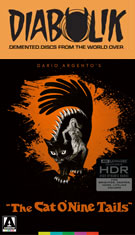
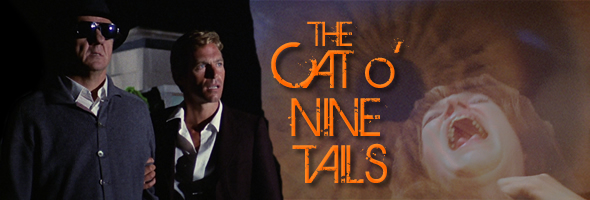
Color, 1971, 111 mins. 48 secs. / 113 mins. 52 secs. / 92 mins. 19 secs.
Directed by Dario Argento
Starring James Franciscus, Karl Malden, Catherine Spaak, Pier Paolo Capponi, Horst Frank, Rada Rassimov, Cinzia De Carolis, Werner Pochath
Arrow Video (UHD, Blu-ray & DVD) (US/UK RA/B/0 4K/HD/NTSC/PAL), Blue Underground (Blu-Ray & DVD) (US R0 HD/PAL), '84 Films (Blu-ray & DVD) (Germany R0 HD/PAL), Anchor Bay (US R0 NTSC), Benelux (Holland R2 PAL), Medusa (Italy R2 PAL), TFI (France R2 PAL) / WS (2.35:1) (16:9)
After scoring 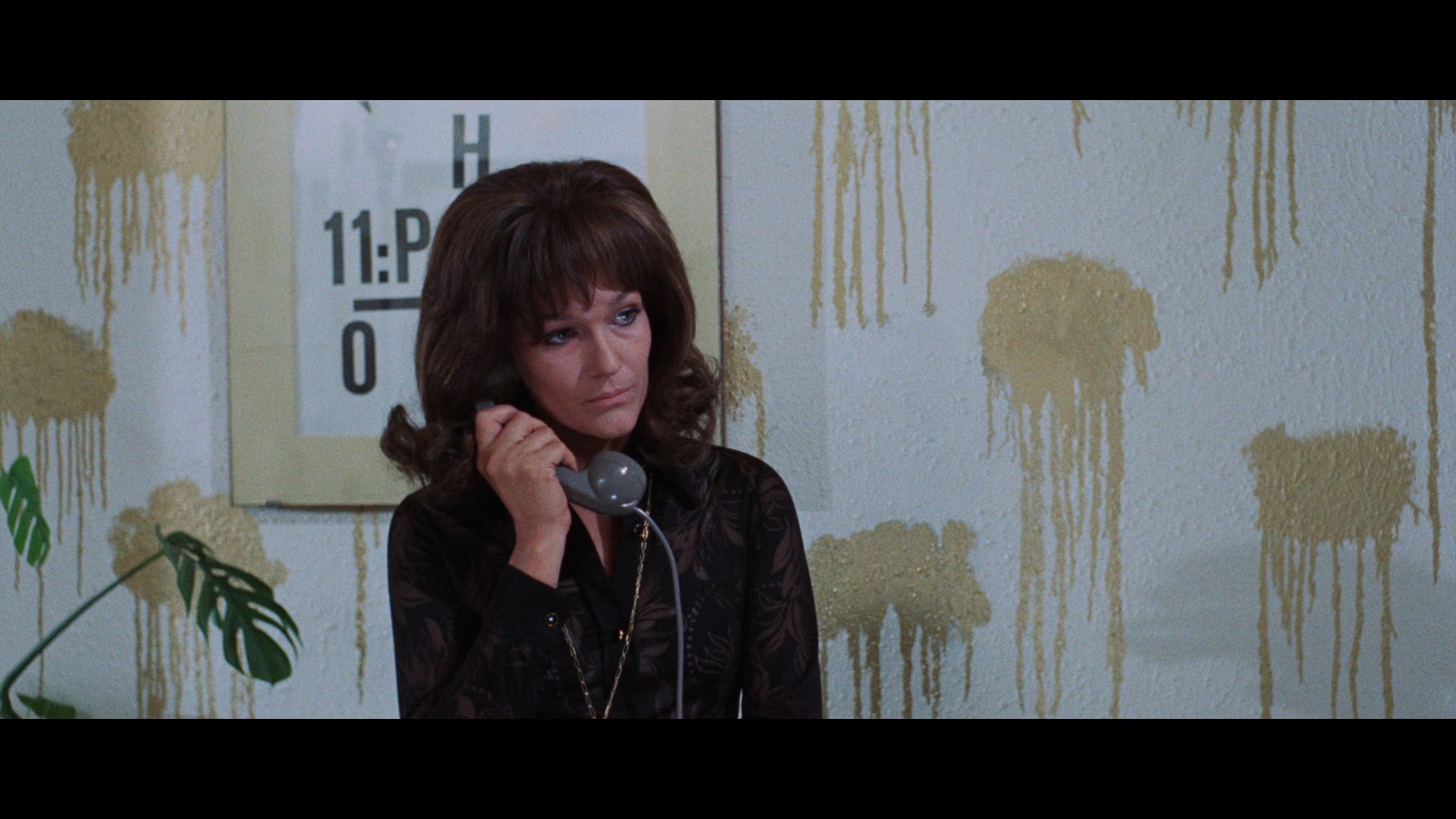 a major international success with his first film, The Bird with the Crystal Plumage, director Dario Argento
a major international success with his first film, The Bird with the Crystal Plumage, director Dario Argento 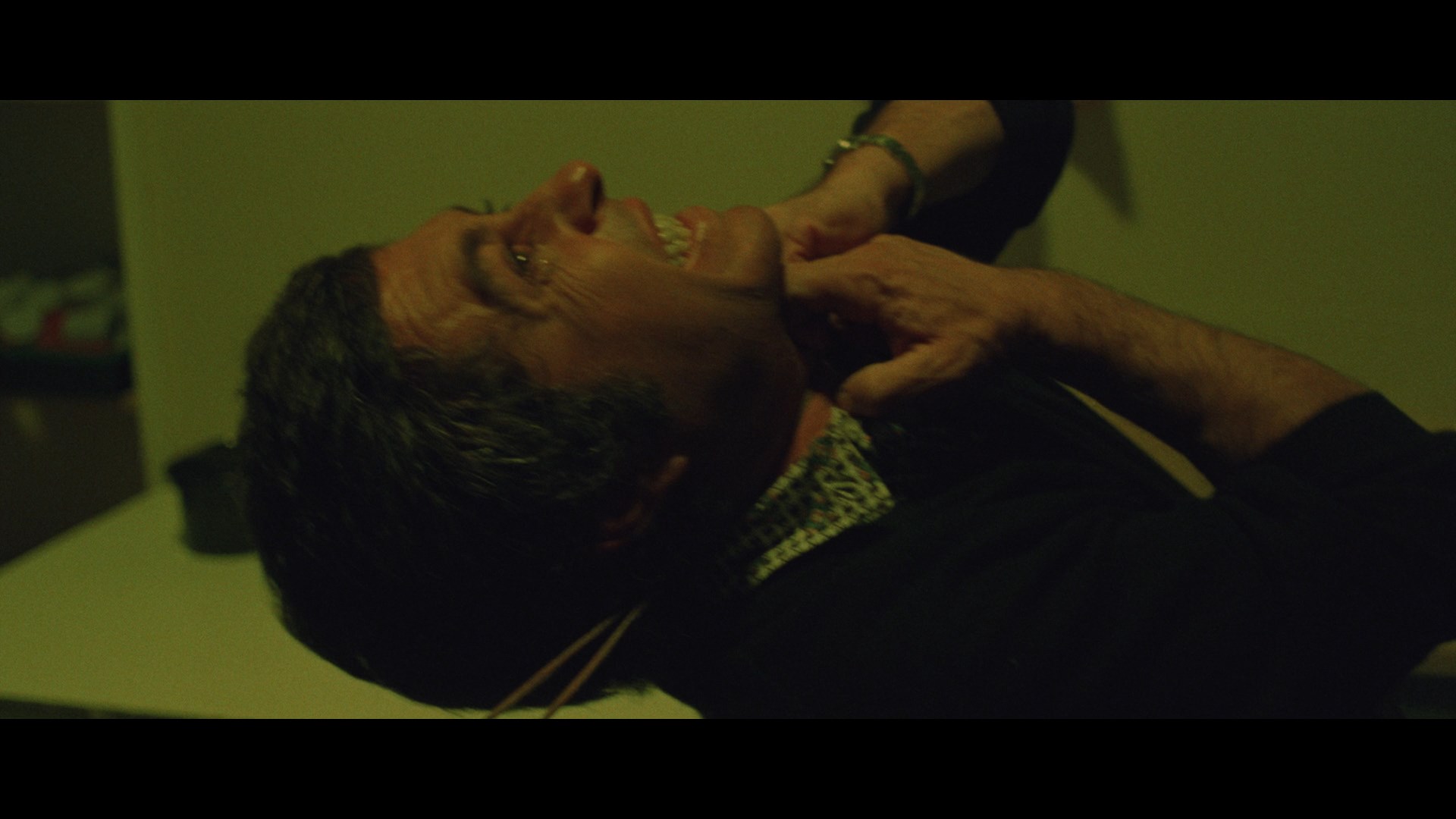 quickly attempted a reprise by expanding that trendsetting giallo's formula of Americans in Italy rubbing shoulders with the criminal element and a psychopathic killer. The end result, The Cat o' Nine Tails, didn't initially capture the critical and commercial appeal of that first hit thanks to its abrasive insistence on refusing to conform to expectations as romantic subplots, whodunit elements, and standard three-act plotting are all tossed out the window with a glee bordering on the sadistic, allowing Argento instead to experiment with the template of a murder mystery in which form and style coexist most uneasily. After this film Argento returned one year later with the even more radical Four Flies on Grey Velvet before launching onto a different plane entirely with two masterpieces in a row, Deep Red and Suspiria.
quickly attempted a reprise by expanding that trendsetting giallo's formula of Americans in Italy rubbing shoulders with the criminal element and a psychopathic killer. The end result, The Cat o' Nine Tails, didn't initially capture the critical and commercial appeal of that first hit thanks to its abrasive insistence on refusing to conform to expectations as romantic subplots, whodunit elements, and standard three-act plotting are all tossed out the window with a glee bordering on the sadistic, allowing Argento instead to experiment with the template of a murder mystery in which form and style coexist most uneasily. After this film Argento returned one year later with the even more radical Four Flies on Grey Velvet before launching onto a different plane entirely with two masterpieces in a row, Deep Red and Suspiria.
While strolling at night with his ward, Lori (De Carolis), blind retired reporter Franco Arno (Malden) overhears a conversation in a parked car involving blackmail. Following a break-in at the prestigious Terzi Institute for genetic research, one of the leading researchers winds up decapitated by a passenger train the next morning. The victim happened to be a 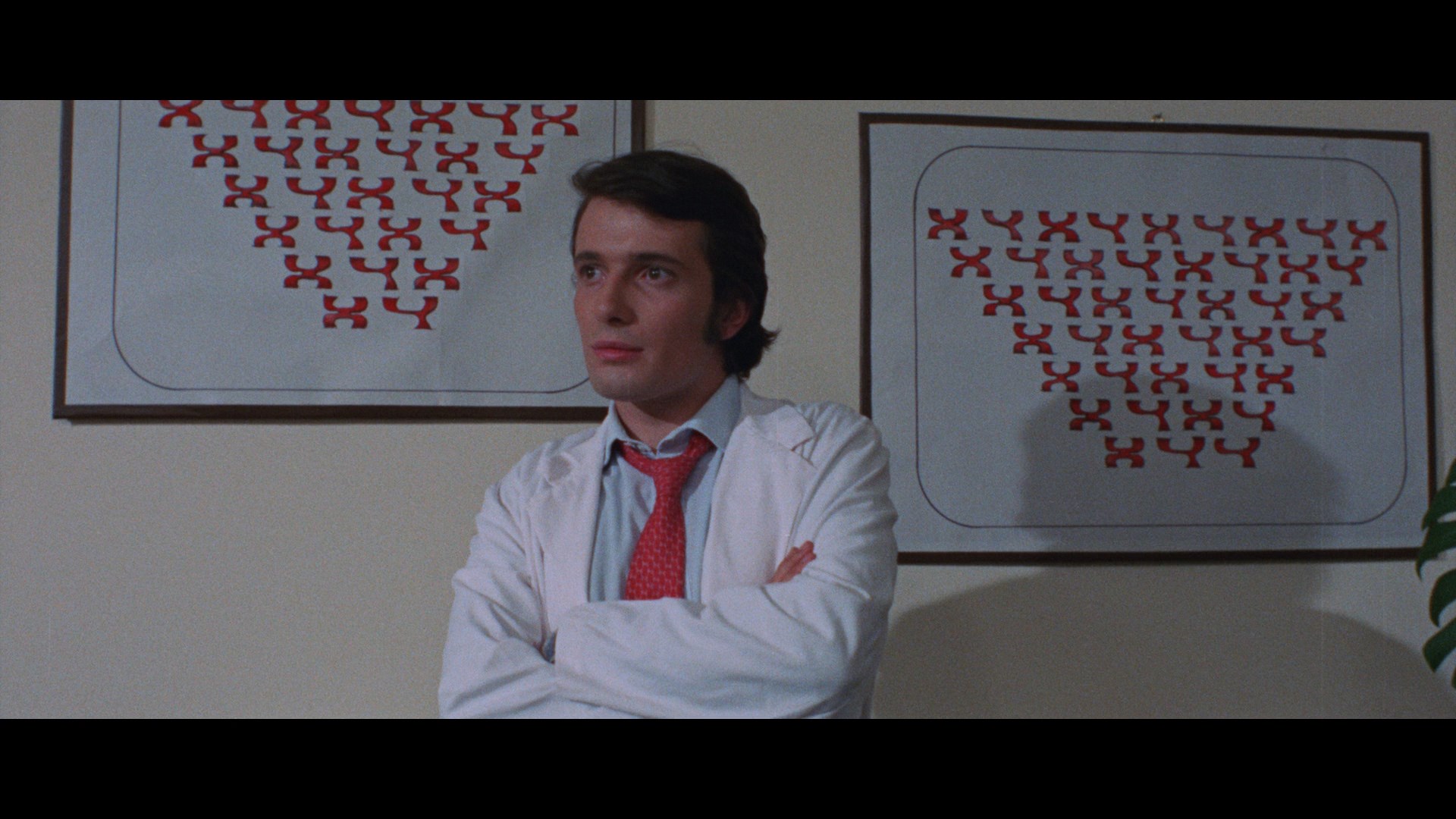 participant in the blackmail discussion, so Arno teams up with scrappy newsman Carlo Giordani (Franciscus), both of whom get more than they bargained for. Carlo gets close to Anna (Spaak), the mysterious daughter of the institute chairman, while Arno chases down several clues of his own. Meanwhile the garrote-wielding killer continues to strike again and again, determined to cover up a most deadly secret.
participant in the blackmail discussion, so Arno teams up with scrappy newsman Carlo Giordani (Franciscus), both of whom get more than they bargained for. Carlo gets close to Anna (Spaak), the mysterious daughter of the institute chairman, while Arno chases down several clues of his own. Meanwhile the garrote-wielding killer continues to strike again and again, determined to cover up a most deadly secret. 
Though Argento's previous film had its share of quirky moments, Cat fractures itself entirely into a series of bizarre incidents. A mysterious locket, a champion cursing pro from the underworld, a deadly gay love triangle, chromosome experiments on murderers, a razor-happy barber, and a speedy police chase through a parking deck are just a few of the odd tricks up Argento's sleeve. Though the tone of the film is eerily antiseptic and jagged, the characters are among Argento's warmest with Franciscus and Malden making a most appealing pair of sleuths. The violent finale deliberately subverts viewer expectations by operating less as a whodunit than a nasty piece of narrative machinery which leaves its major characters, some of whose outcomes are never confirmed, emotionally or physically scarred for the rest of their lives. Ennio Morricone's score performs a similar function, beginning with a soft and sweet lullaby theme before plunging into some of his darkest, strangest jazz improvisations, with shots of the killer's eyes 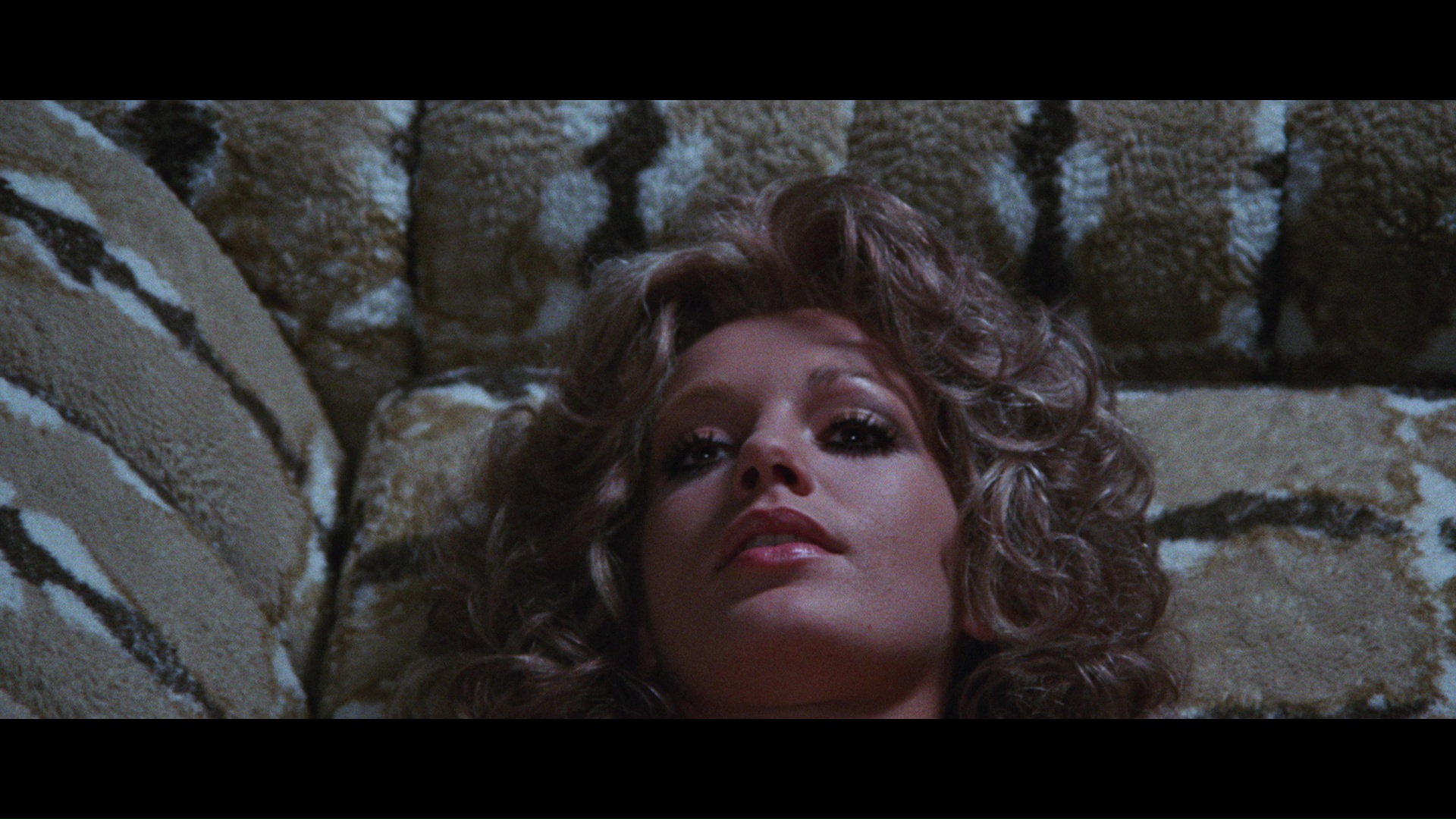 punctuated by disturbing musical clicks, yowls, and thuds. Cat also finds Argento experimenting more with the possibilities of editing to layer his narrative, such as the obvious example of subliminal flashes used to indicate an upcoming scene or recap an important piece of information. He later expanded on this technique in Four Flies (particularly the memorable finale) and, most effectively, in the celebrated visual and verbal echoing of Deep Red. The murder sequences themselves are brutal though comparatively light on blood; in fact, the rough rooftop finale is the goriest sequence in the film, sort of a savage updating of the climax from To Catch a Thief. The strangulation of Rada Rassimov is probably the most memorably brutal moment though, a protracted bit of nastiness with touches which Argento would later repeat and embellish in Deep Red as well.
punctuated by disturbing musical clicks, yowls, and thuds. Cat also finds Argento experimenting more with the possibilities of editing to layer his narrative, such as the obvious example of subliminal flashes used to indicate an upcoming scene or recap an important piece of information. He later expanded on this technique in Four Flies (particularly the memorable finale) and, most effectively, in the celebrated visual and verbal echoing of Deep Red. The murder sequences themselves are brutal though comparatively light on blood; in fact, the rough rooftop finale is the goriest sequence in the film, sort of a savage updating of the climax from To Catch a Thief. The strangulation of Rada Rassimov is probably the most memorably brutal moment though, a protracted bit of nastiness with touches which Argento would later repeat and embellish in Deep Red as well.
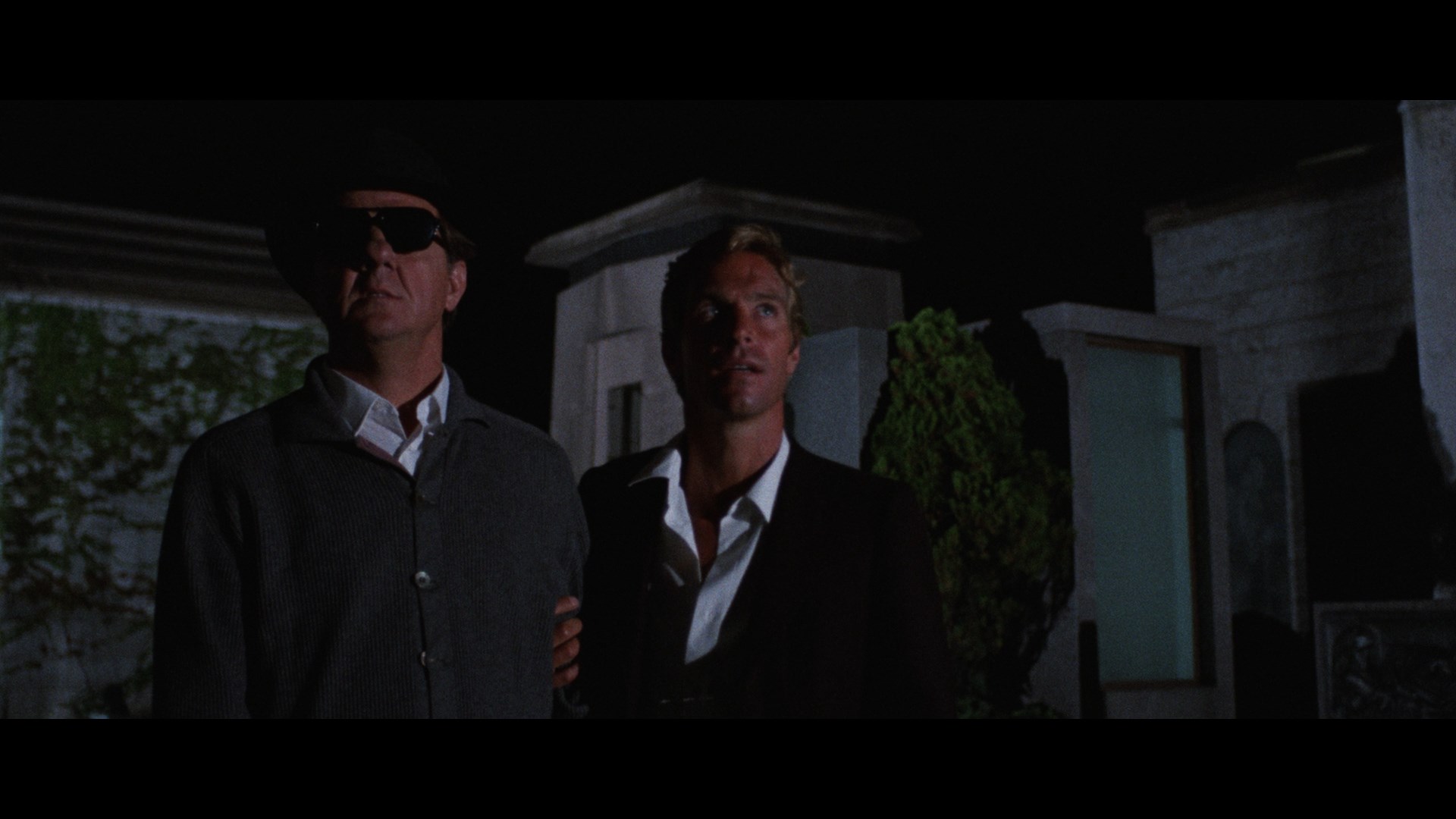
For many years after its release, Cat was one of the hardest Argento films to see in anything resembling its original form or a decent print. An RCA Japanese laserdisc came to the relief of some collectors; letterboxed at approximately 2.00:1 and sporting an odd goldish tint, this was the best option available compared to, say, the slaughtered TV print offered by Bingo Video on VHS in America (which cut over 22 minutes of material including much of the violence as well as the barber and car 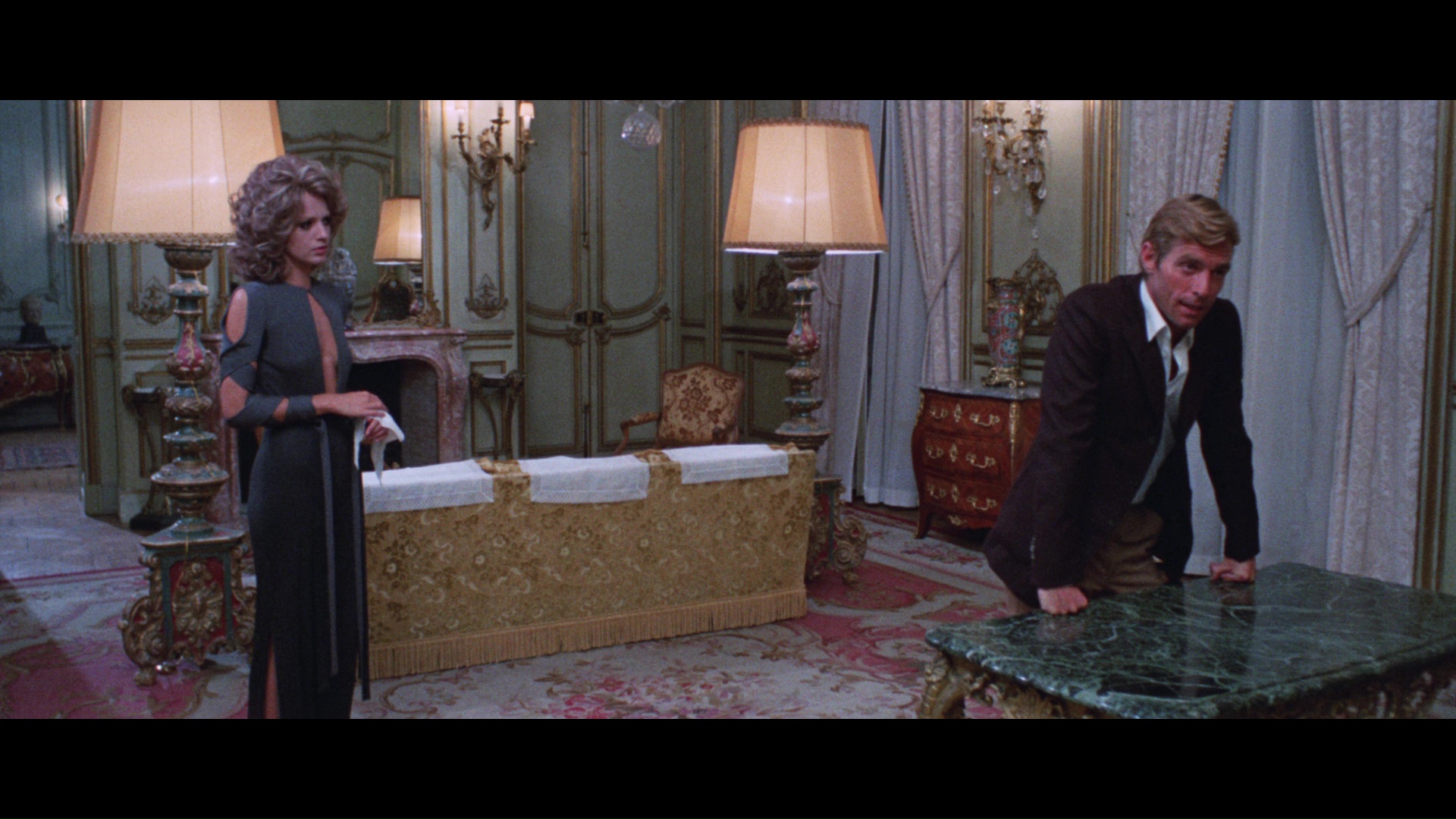 chase scenes); this wretched presentation is still available on bootleg DVD from several bargain labels. (Also like Bird, Cat was rated GP for its theatrical U.S. run, which just goes to show how out of whack the MPAA has gotten in the last few decades.)
chase scenes); this wretched presentation is still available on bootleg DVD from several bargain labels. (Also like Bird, Cat was rated GP for its theatrical U.S. run, which just goes to show how out of whack the MPAA has gotten in the last few decades.)
Bearing these factors in mind, Anchor Bay's official DVD of Cat in 2000 (later reissued by Blue Underground with identical contents) was a salvation for the film at the time. Apart from the noticeably scratchy credits which appeared to be spliced in from another print, the element for this release is clean and comparatively improved, not to mention uncensored. The stereo audio is limited mostly to Morricone's score, which has been rechanneled to the front speakers; even the car chase plays out almost entirely in mono. The disc also includes surround tracks in Italian and French-- without subtitles or captions, alas. However, an English subtitle track is activated to translate some on-screen text (newspapers, identifying building plaques, etc.) in Italian, as opposed to the Japanese LD which used awkwardly inserted English language footage (with much paler color) instead. Extras include "Tales of the Cat," a standard featurette in which Argento, Morricone, and co-writer Dardano Saccheti offer a thumbnail version  of the circumstances which led to the film's creation, complete with views of its successes and faults, though Argento seems a bit too hard on it in retrospect. The promotional material is at least as interesting; an immaculate international trailer features a delirious mixture of footage and tinted stills to create a genuinely appealing promotional piece, including a psychedelic rock instrumental borrowed from the film May Morning. This trailer was obviously reworked to lesser effect for the U.S. trailer and TV spots (in much more battered condition), which spoil the visuals with some unconvincing verbal hype. Finally you get some appreciative liner notes by Travis Crawford, a gallery of posters and stills, and two radio promos featuring some highly unorthodox soundbites from the two stars.
The Dutch DVD features a similar English-
of the circumstances which led to the film's creation, complete with views of its successes and faults, though Argento seems a bit too hard on it in retrospect. The promotional material is at least as interesting; an immaculate international trailer features a delirious mixture of footage and tinted stills to create a genuinely appealing promotional piece, including a psychedelic rock instrumental borrowed from the film May Morning. This trailer was obviously reworked to lesser effect for the U.S. trailer and TV spots (in much more battered condition), which spoil the visuals with some unconvincing verbal hype. Finally you get some appreciative liner notes by Travis Crawford, a gallery of posters and stills, and two radio promos featuring some highly unorthodox soundbites from the two stars.
The Dutch DVD features a similar English-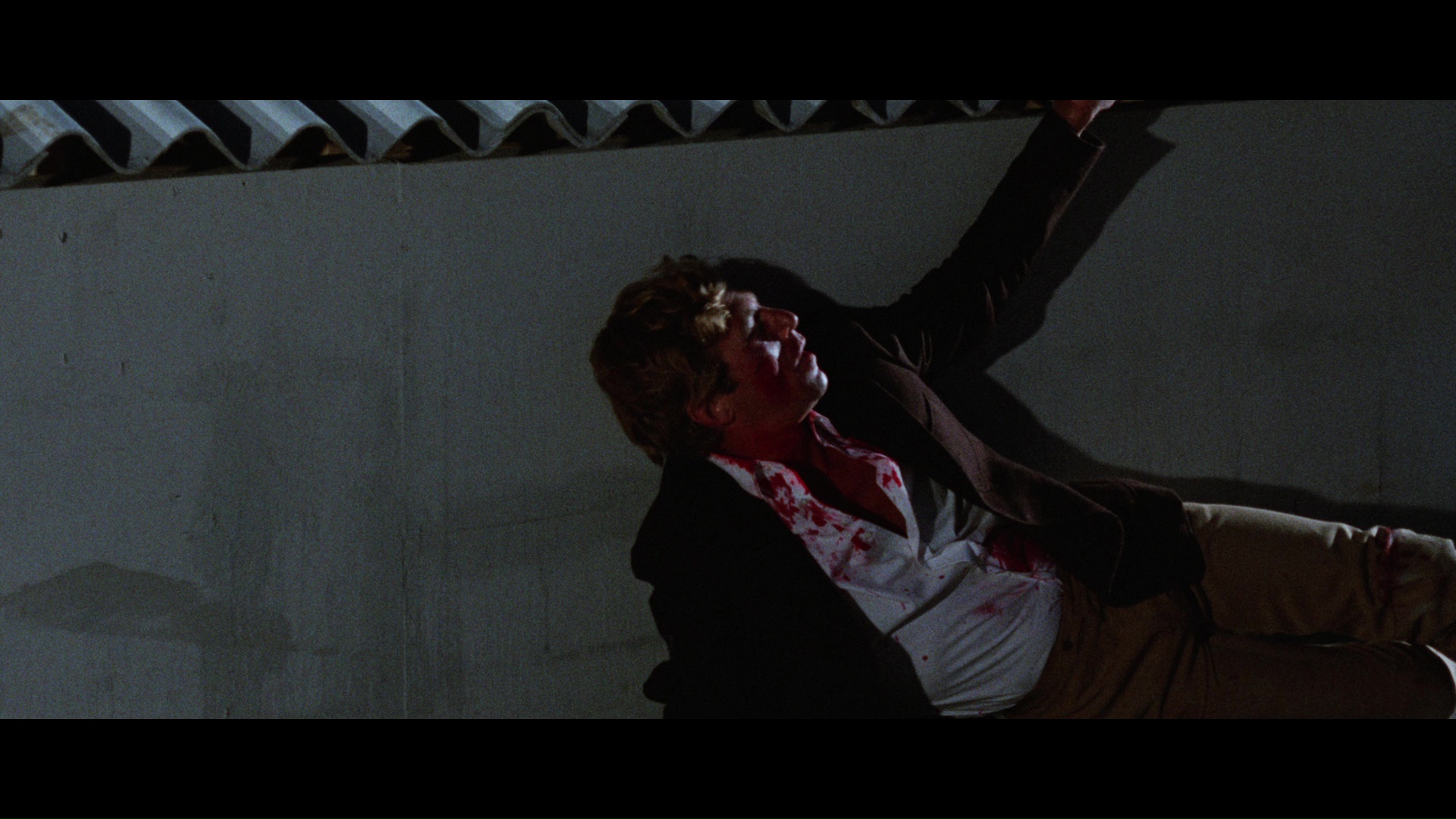 language transfer with Dutch subtitles, while the French disc contains Italian and French tracks with optional French subtitles. One interesting alternative is the Medusa disc from Italy which offers a few twists of its own and is worth picking up for Argento die-hards. The Italian language version is presented in Dolby Digital 5.1 or 2.0 mono with optional English subtitles; while the 5.1 track is an artificial-sounding wreck (though not as disastrous as Medusa's botched mix on Tenebrae), the 2.0 mix sounds fine and offers a somewhat different experience from the English language edition. The actors are voiced in a far more lively fashion which, surprisingly enough, gives the film a markedly energetic and engaging tone, while the murders feature far more dramatic screaming, gurgling, and other noises the voice artists conjured up probably after swilling a lot of vino. No extras to speak of.
language transfer with Dutch subtitles, while the French disc contains Italian and French tracks with optional French subtitles. One interesting alternative is the Medusa disc from Italy which offers a few twists of its own and is worth picking up for Argento die-hards. The Italian language version is presented in Dolby Digital 5.1 or 2.0 mono with optional English subtitles; while the 5.1 track is an artificial-sounding wreck (though not as disastrous as Medusa's botched mix on Tenebrae), the 2.0 mix sounds fine and offers a somewhat different experience from the English language edition. The actors are voiced in a far more lively fashion which, surprisingly enough, gives the film a markedly energetic and engaging tone, while the murders feature far more dramatic screaming, gurgling, and other noises the voice artists conjured up probably after swilling a lot of vino. No extras to speak of. 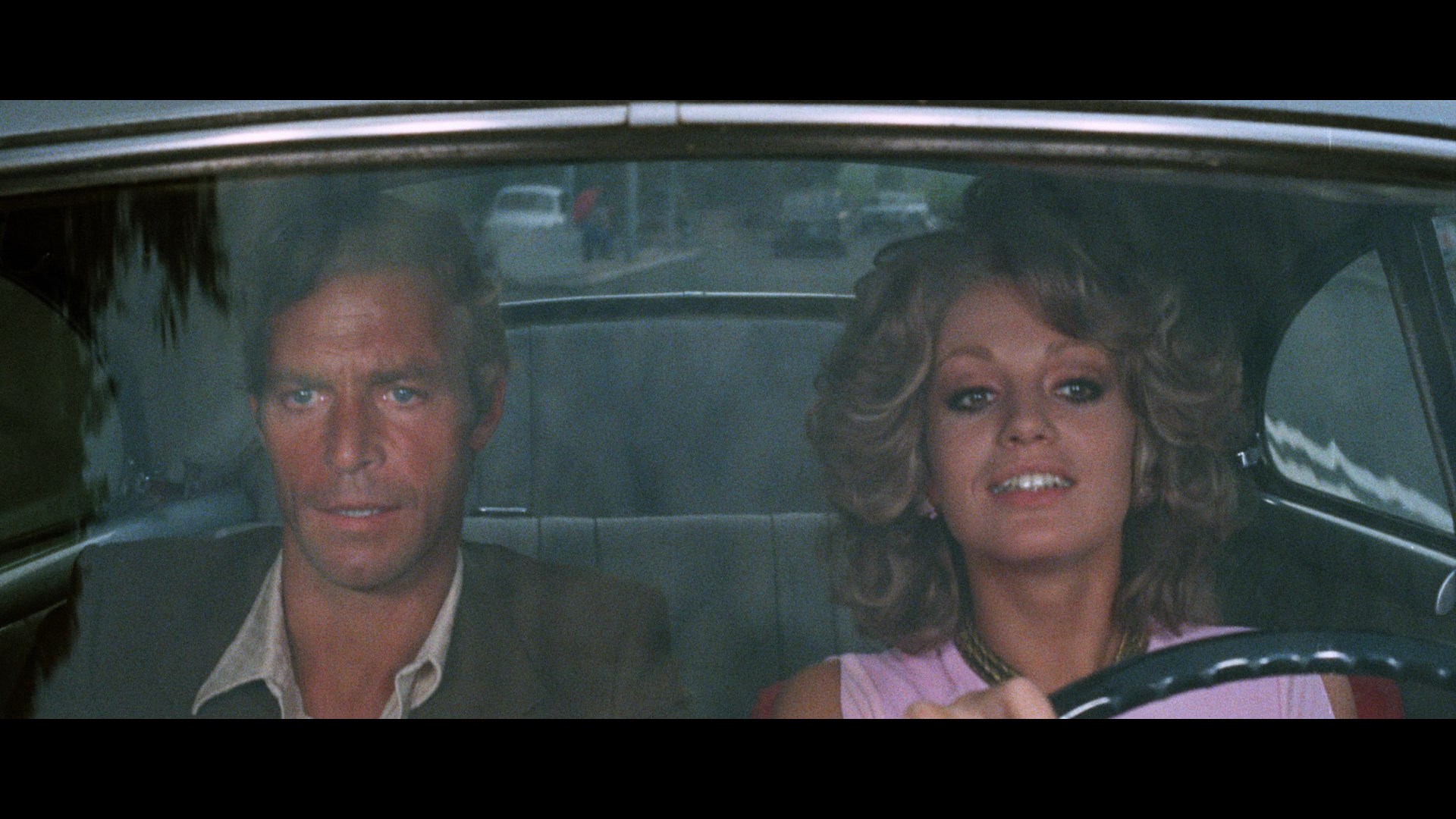
In 2011, Blue Underground's Blu-ray release proved to be a controversial one as it was one of the first releases to really display signs of what would become known in later years as that dreaded Italian scanner noise-- though it's comparatively restrained here and nowhere near later disasters like The 10th Victim, 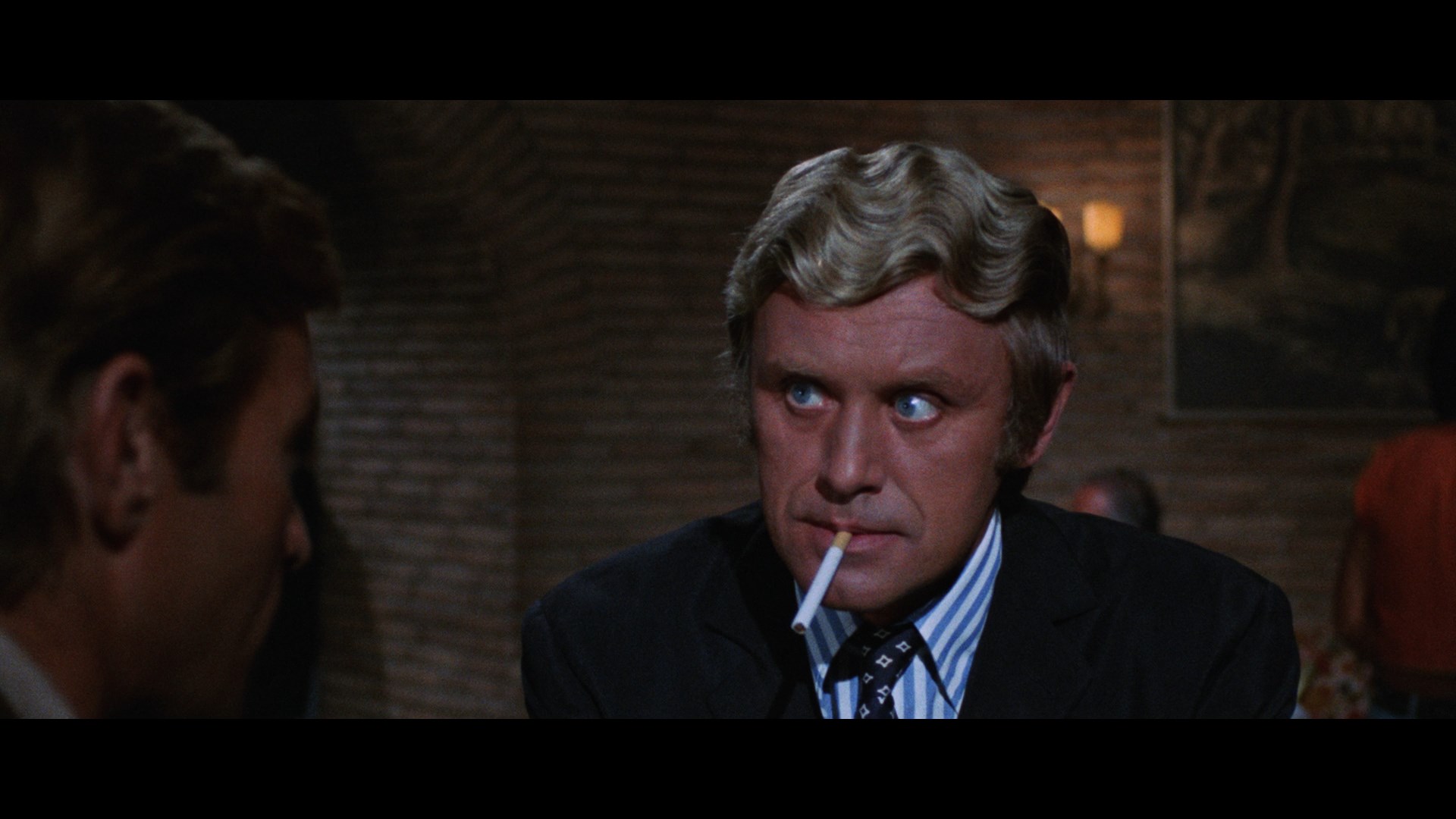 The House by the Cemetery, or much of the Raro catalog. Since its release this was often been cited as the most visually drab of Argento's classic films, but that view was finally put firmly to rest as it's now obvious that it was originally shot in rich, Technicolor hues that rival the most striking images in his other two "Animal Trilogy" thrillers. From Malden's book-lined apartment to the sleek, Tenebrae-style modernistic interiors of the Terzi Instititue, the film takes a significant step forward in aesthetic rewards here with better color and detail than earlier transfers, though it would be outdone as you'll see below. The image clarity is so fine you can also clearly see how they pulled off the fleeting but very nasty cheek-slashing effect with a scalpel, too. The English opening and closing titles are now in mint condition as well. The English, Italian, and French tracks are all present here along with the of subtitles in English, French, and Spanish; the one caveat is that the English subs are SDH, which means that sound effects and voice directions are included as well which might make it a bit awkward for anyone watching it in Italian. The featurette, trailers, TV and radio spots are all included; the only missing extra is the stills gallery, which is a shame as it included a glimpse of the film's deleted epilogue which concluded in a more traditional and romantic fashion. Incidentally, fans may also want to seek out the 1971 movie tie-in paperback, which features yet another resolution as well as numerous bits of additional character and plot information. A subsequent UK Blu-ray from Arrow the same year was taken from the same transfer but featured a vastly inferior presentation
The House by the Cemetery, or much of the Raro catalog. Since its release this was often been cited as the most visually drab of Argento's classic films, but that view was finally put firmly to rest as it's now obvious that it was originally shot in rich, Technicolor hues that rival the most striking images in his other two "Animal Trilogy" thrillers. From Malden's book-lined apartment to the sleek, Tenebrae-style modernistic interiors of the Terzi Instititue, the film takes a significant step forward in aesthetic rewards here with better color and detail than earlier transfers, though it would be outdone as you'll see below. The image clarity is so fine you can also clearly see how they pulled off the fleeting but very nasty cheek-slashing effect with a scalpel, too. The English opening and closing titles are now in mint condition as well. The English, Italian, and French tracks are all present here along with the of subtitles in English, French, and Spanish; the one caveat is that the English subs are SDH, which means that sound effects and voice directions are included as well which might make it a bit awkward for anyone watching it in Italian. The featurette, trailers, TV and radio spots are all included; the only missing extra is the stills gallery, which is a shame as it included a glimpse of the film's deleted epilogue which concluded in a more traditional and romantic fashion. Incidentally, fans may also want to seek out the 1971 movie tie-in paperback, which features yet another resolution as well as numerous bits of additional character and plot information. A subsequent UK Blu-ray from Arrow the same year was taken from the same transfer but featured a vastly inferior presentation 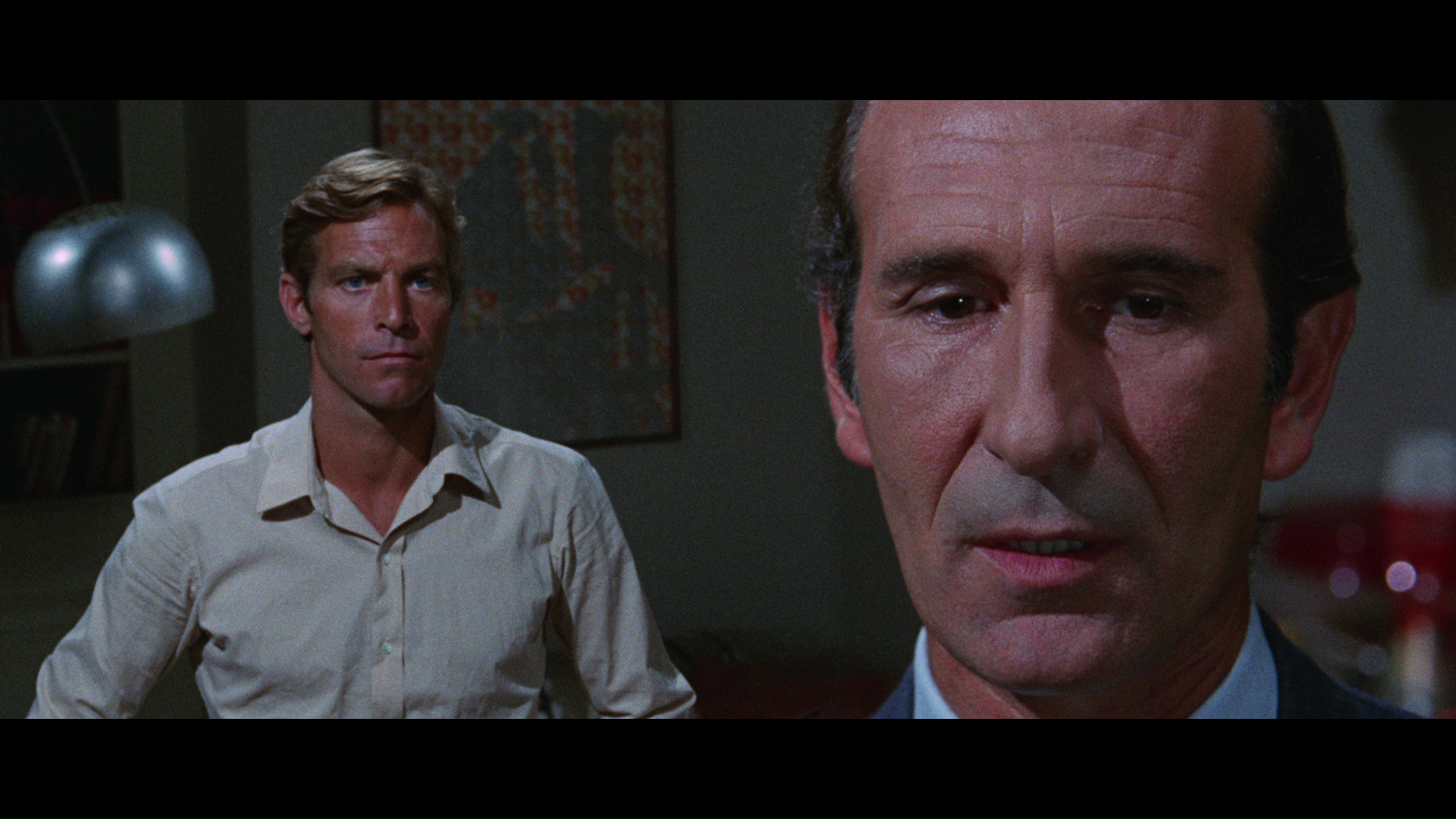 with some major sync issues throughout the English soundtrack. That said, the release may be of some interest to Argentophiles for its exclusive video interviews with Argento (10m31s), Luigi
with some major sync issues throughout the English soundtrack. That said, the release may be of some interest to Argentophiles for its exclusive video interviews with Argento (10m31s), Luigi 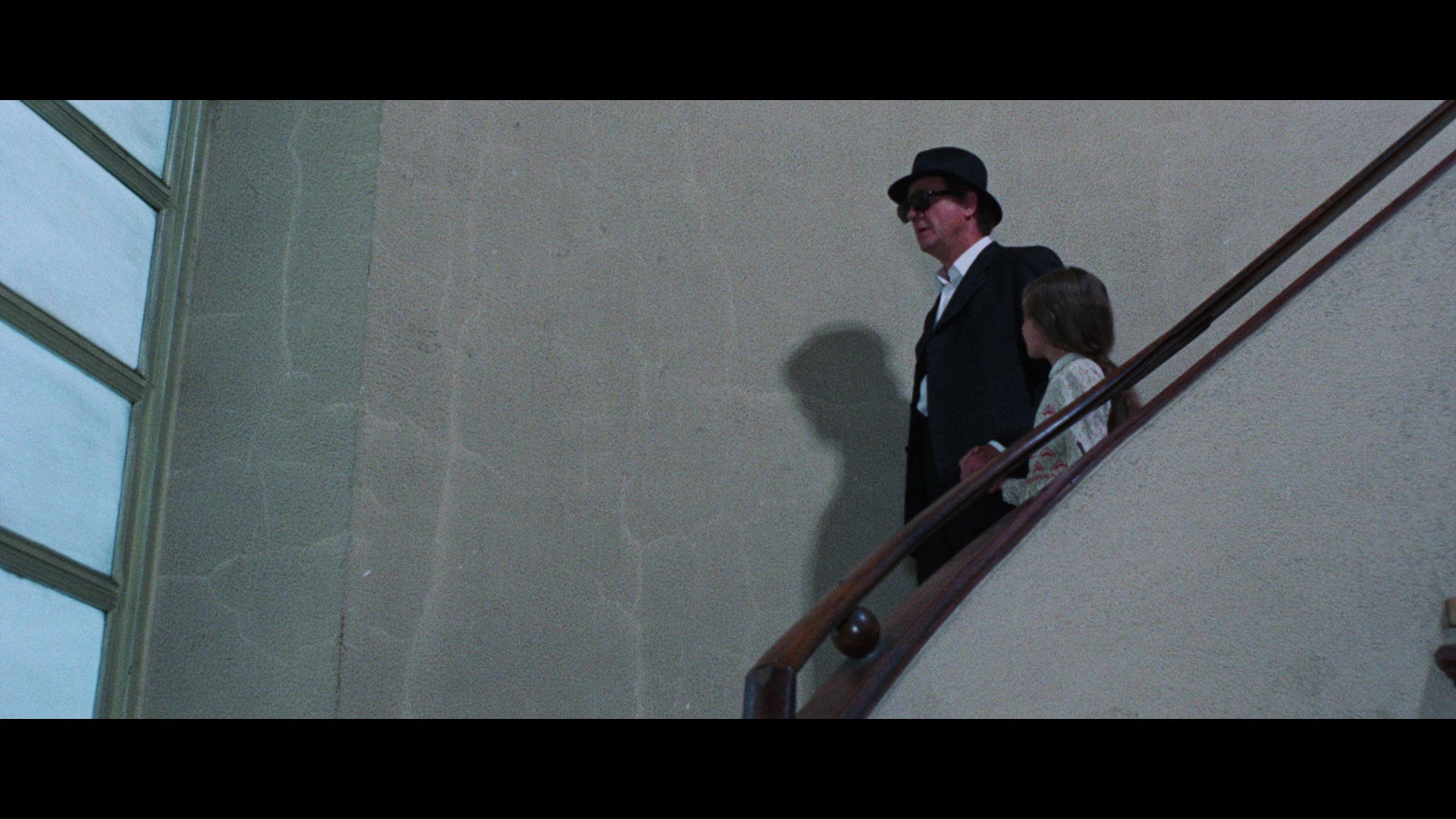 Cozzi (16m24s), and for some reason Sergio Martino (24m5s), plus liner notes by Alan Jones.
Cozzi (16m24s), and for some reason Sergio Martino (24m5s), plus liner notes by Alan Jones.
An interesting oddity later popped up in Germany (where the film was advertised as a Bryan Edgar Wallace thriller a la Plumage), first on DVD and then as part of a limited edition 3-disc set (one Blu-ray, two DVDs) from '84 Films. The standard theatrical edition is included on the Blu-ray (with English or German Dolby Digital mono audio options with optional German subtitles), everything from the Blue Underground release ("Tales of the Cat," radio interviews, international and American trailers, radio spots, TV spots, gallery), plus the German and Italian trailers. There's also a separate option to watch some additional German footage (3m2s) which consists of an extra scene with Tassoni and Werner Pochath meeting in the his private office to talk about plans to cut off their employment contract together and Braun's desire to go back to Germany, then Giordani having an extended mull over Pochath's dead body. Not to be overlooked for curiosity value is the drastically abbreviated German theatrical cut (in English or German language options), which runs just over an hour and half and streamlines the film quite a bit while toning down the violence (such as removing one nasty bit of scalpel mutilation and cutting off Rassimov's death just after the initial strangulation and before she gets pummeled on the floor). The first DVD replicates the same content, but the second DVD is the really fascinating one as it contains the full extended German version. The extra scenes are in dupey, VHS-level quality with optional English subtitles, but it's fascinating to see how they alter the flow of the film. Supplements include the German and two English-language trailers, TV spots, and massive separate galleries of German, Italian, American, and French lobby cards, press kits, publicity photos, and other visual 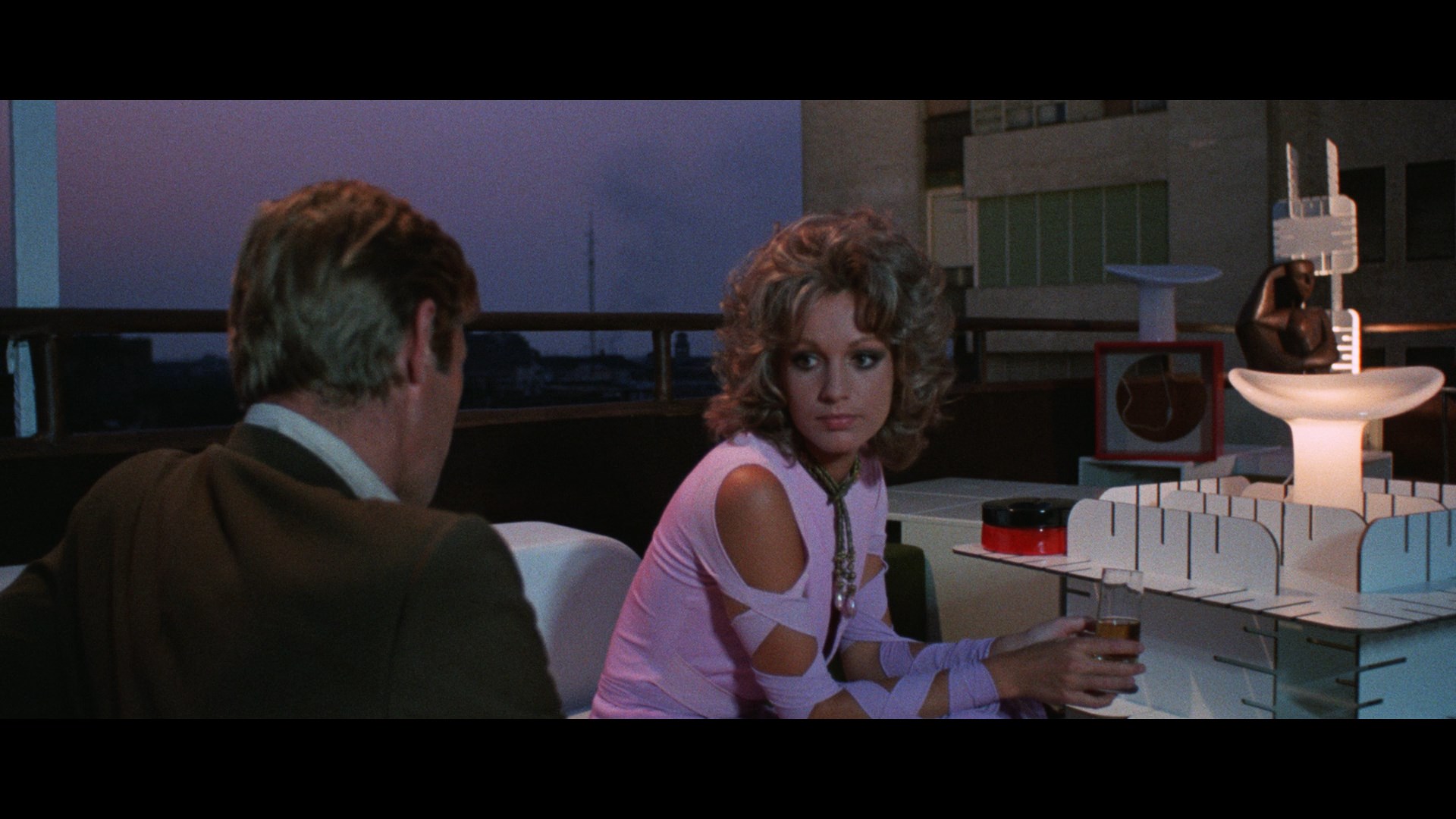 ephemera.
ephemera.
Finally in early 2018, Arrow finally gave the film a much-needed new 4K 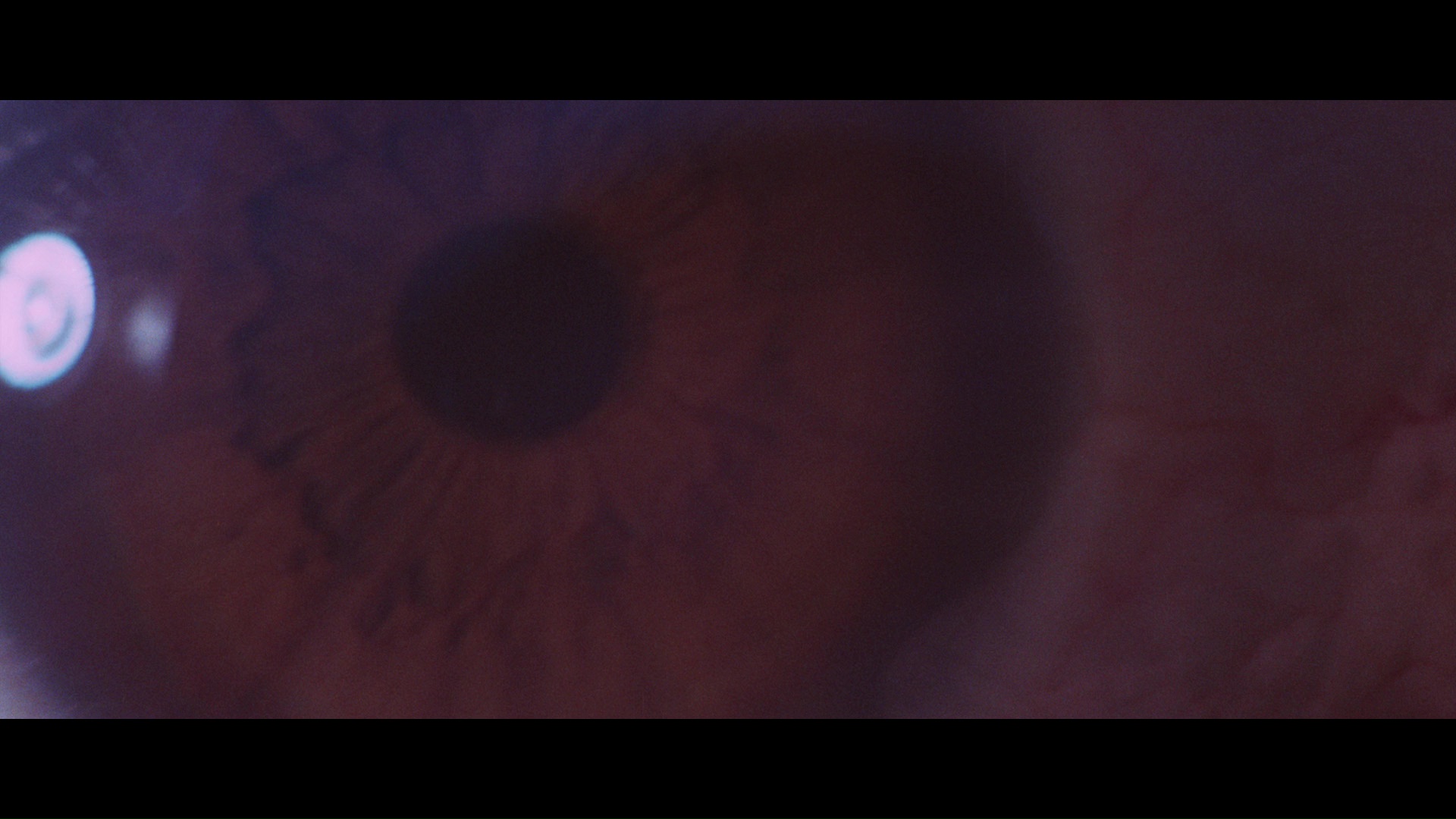 transfer from the original negative that results in a presentation similar to its 2017 work on Crystal Plumage; in other words it's definitely going to provoke strong reactions as it looks darker, richer, subtly graded, and with much more fine film grain versus the more digitized look of the older transfer. The compression is extremely attentive as well and doesn't result in any visible issues. Both the English and Italian tracks are included back in their original mono (DTS-HD MA), sounding excellent, with optional English or English SDH subtitles for whichever you choose (and title sequences and text inserts in English or Italian as well). An audio commentary with the reliable team of Alan Jones and Kim Newman is a major plus as well, covering Argento's newcomer status at the time as a director (and his stated disdain for this film years later), the prevalence of blindness-themed thrillers before and around this time, the state of the Italian film industry at the time, and plenty more. A new Argento interview, "Nine Lives" (15m57s), reiterates the "stereotypical American elements" that dissatisfied him (in contrast to the positive audience response), the Turin location scouting, an allusion to "terrible pranks" pulled by the crew in the cemetery scene, his fondness for Malden, and his own newspaper background. In "The Writer o' Many Tales" (34m46s), wildly productive and influential screenwriter Dardano Sacchetti covers his own passion for cinema that got him into the business, his first meeting with Argento, and the real-life inspiration for the aberrant chromosome plot device that plays a pivotal role in the story. A new interview with De Carolis, "Child Star" (11m2s), is worth checking out as the former child star talks about working with Malden (whose fame was unknown to her at the time), her mother's constant presence on
transfer from the original negative that results in a presentation similar to its 2017 work on Crystal Plumage; in other words it's definitely going to provoke strong reactions as it looks darker, richer, subtly graded, and with much more fine film grain versus the more digitized look of the older transfer. The compression is extremely attentive as well and doesn't result in any visible issues. Both the English and Italian tracks are included back in their original mono (DTS-HD MA), sounding excellent, with optional English or English SDH subtitles for whichever you choose (and title sequences and text inserts in English or Italian as well). An audio commentary with the reliable team of Alan Jones and Kim Newman is a major plus as well, covering Argento's newcomer status at the time as a director (and his stated disdain for this film years later), the prevalence of blindness-themed thrillers before and around this time, the state of the Italian film industry at the time, and plenty more. A new Argento interview, "Nine Lives" (15m57s), reiterates the "stereotypical American elements" that dissatisfied him (in contrast to the positive audience response), the Turin location scouting, an allusion to "terrible pranks" pulled by the crew in the cemetery scene, his fondness for Malden, and his own newspaper background. In "The Writer o' Many Tales" (34m46s), wildly productive and influential screenwriter Dardano Sacchetti covers his own passion for cinema that got him into the business, his first meeting with Argento, and the real-life inspiration for the aberrant chromosome plot device that plays a pivotal role in the story. A new interview with De Carolis, "Child Star" (11m2s), is worth checking out as the former child star talks about working with Malden (whose fame was unknown to her at the time), her mother's constant presence on 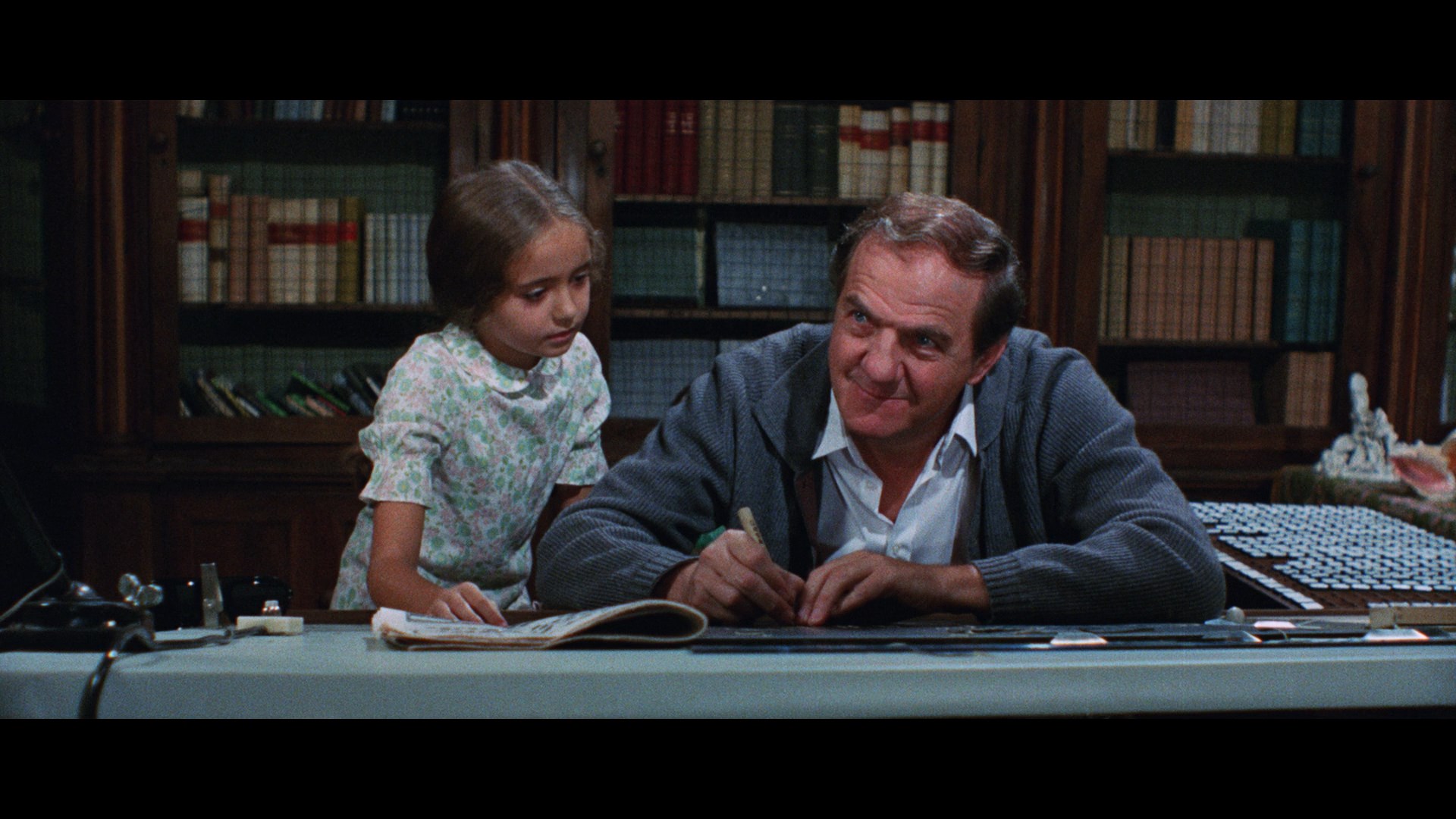 location, and her more vague memories of the later Cannibal Apocalypse opposite John Saxon. In "Giallo in Turin" (15m11s), production manager Angelo Iacono goes into more detail about the city choice for the shoot and explains how the high-speed chase
location, and her more vague memories of the later Cannibal Apocalypse opposite John Saxon. In "Giallo in Turin" (15m11s), production manager Angelo Iacono goes into more detail about the city choice for the shoot and explains how the high-speed chase 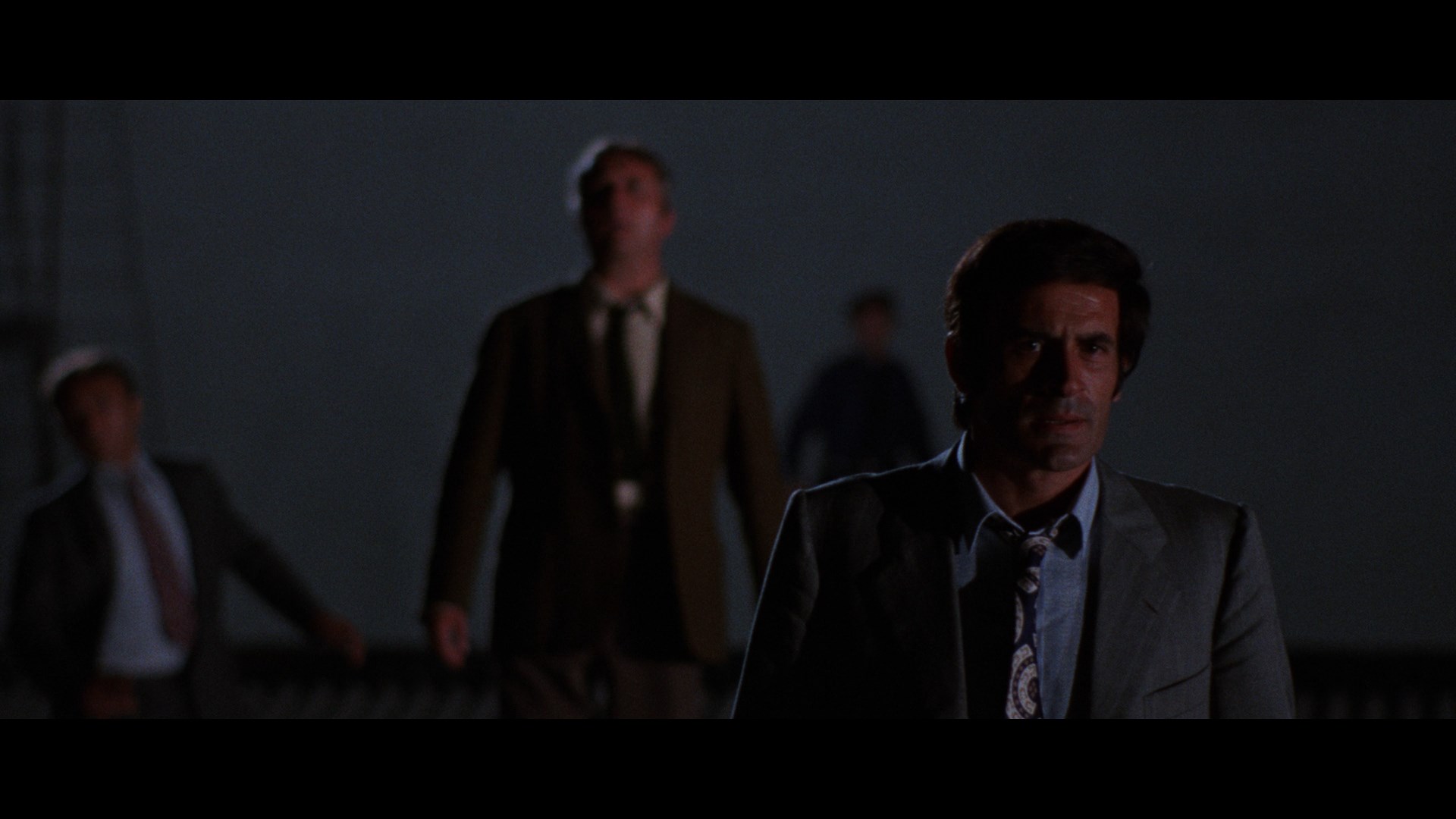 scene was achieved, plus his other work on the set including serving as the deputy for Argento's father/producer. The most in-depth look at the film's discarded original, greatly expanded ending is included here with an English translation of the original script along with copious illustrations showing how the story originally wrapped up all of the pivotal characters. The international, Italian, and American trailers are included, while the limited edition Blu-ray and DVD set also includes reversible sleeve options (original poster art or a striking new red-themed design by Candice Tripp), a double-sided fold-out poster, four reproduction lobby cards, and an illustrated booklet featuring an essay by Argento and new liner notes by Barry Forshaw, Troy Howarth and Howard Hughes.
scene was achieved, plus his other work on the set including serving as the deputy for Argento's father/producer. The most in-depth look at the film's discarded original, greatly expanded ending is included here with an English translation of the original script along with copious illustrations showing how the story originally wrapped up all of the pivotal characters. The international, Italian, and American trailers are included, while the limited edition Blu-ray and DVD set also includes reversible sleeve options (original poster art or a striking new red-themed design by Candice Tripp), a double-sided fold-out poster, four reproduction lobby cards, and an illustrated booklet featuring an essay by Argento and new liner notes by Barry Forshaw, Troy Howarth and Howard Hughes.
In 2021, Arrow Video revisited Argento's film for a 4K UHD edition hot on the heels of its release of Crystal Plumage; the presentation follows suit here, with the addition of HDR giving the more vibrant color scheme a greater range of subtlety here especially when it comes to those vivid reds; the whites also look a notch more balanced here as well. The added resolution really shines in the afternoon outdoor scenes, such as the first daytime shot outside the institute with the street shots now having a nice sense of depth. Audio specs and bonus features are identical to the 2017 Blu-ray, and it comes with limited deluxe packaging (including the liner notes booklet, six postcard lobby card reproductions, and double-sided poster), as well as an even more limited "Arte Originale" edition featuring the original Italian poster art.
ARROW 2017 BLU-RAY
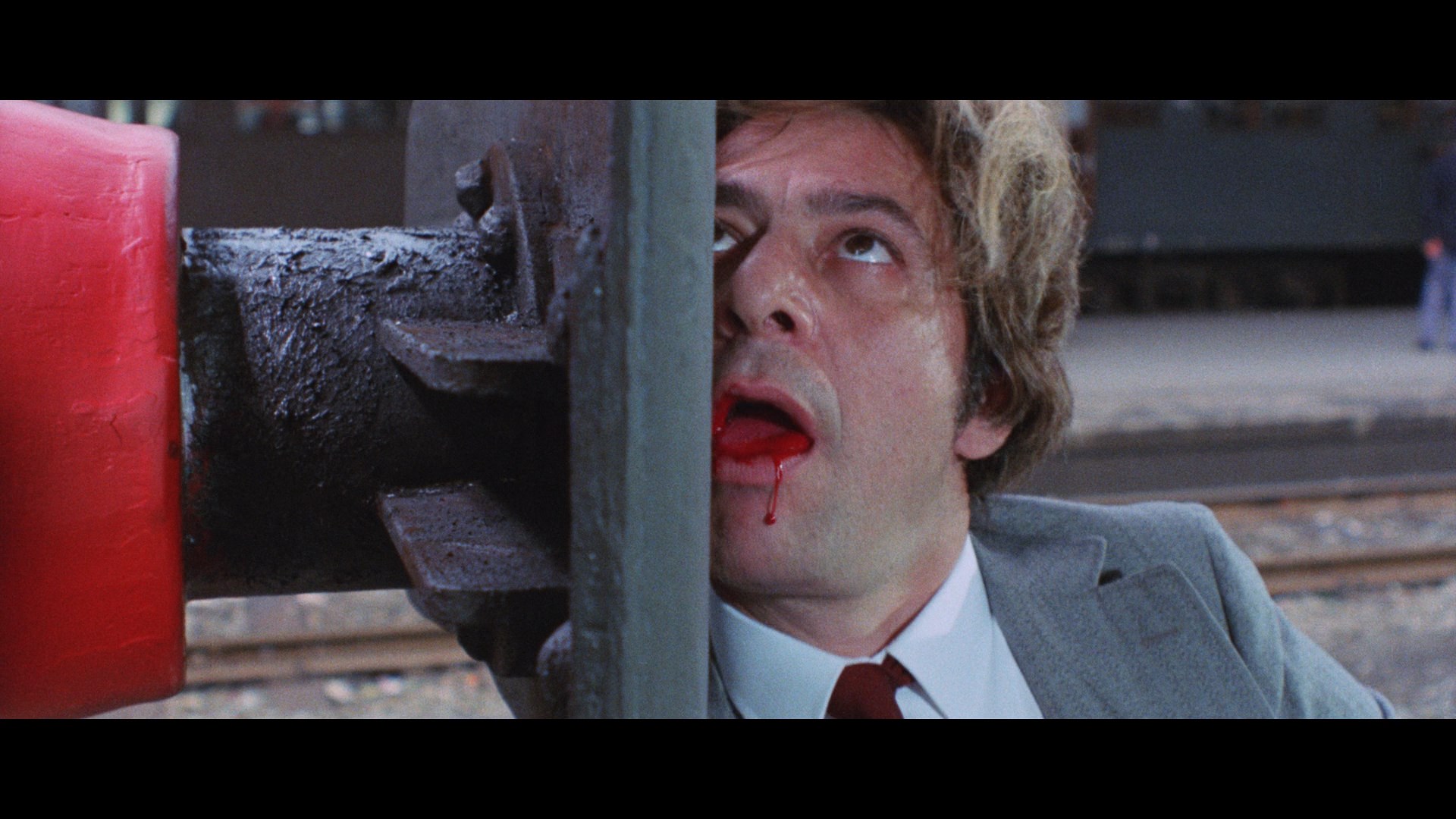



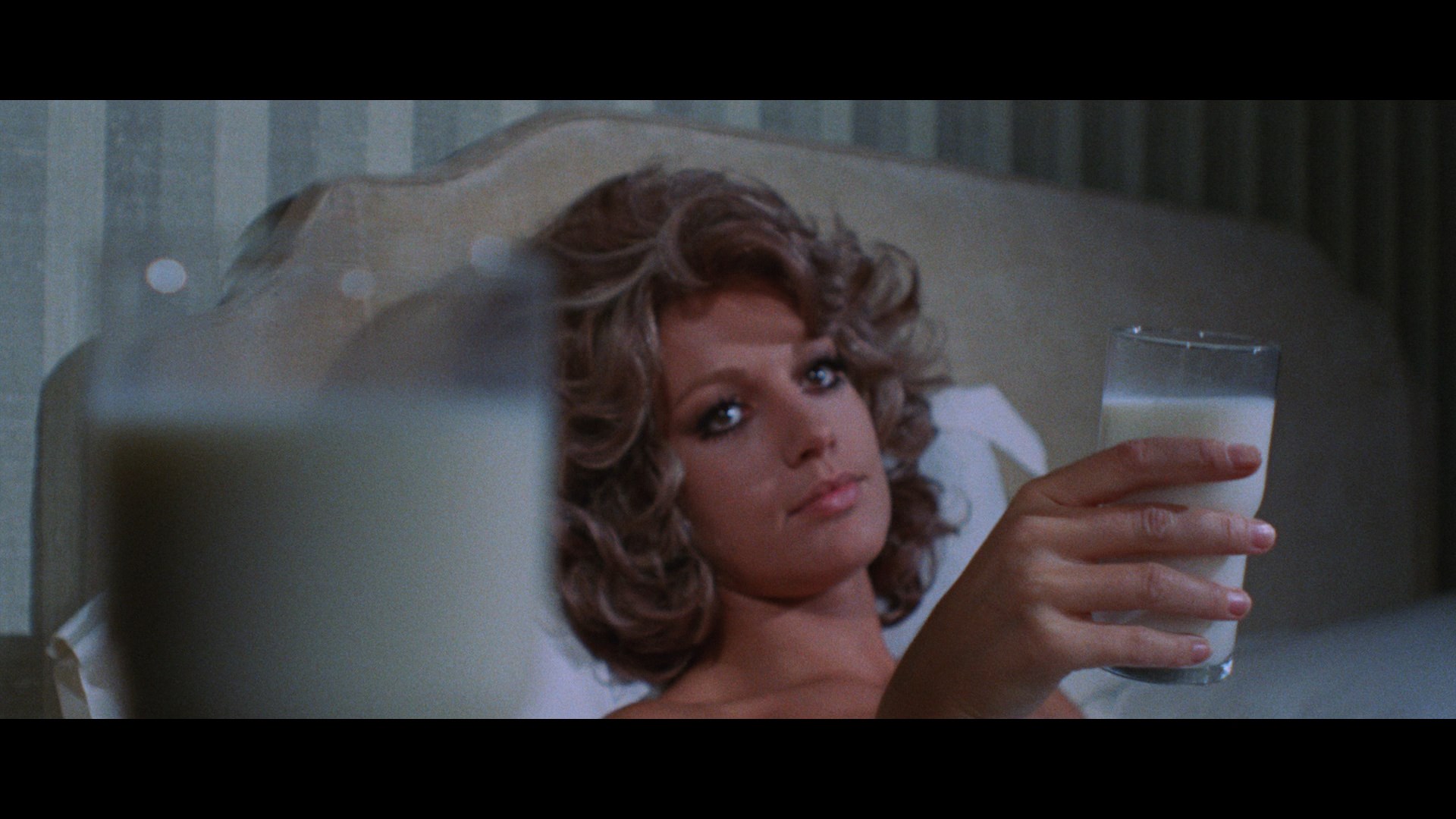
BLUE UNDERGROUND BLU-RAY
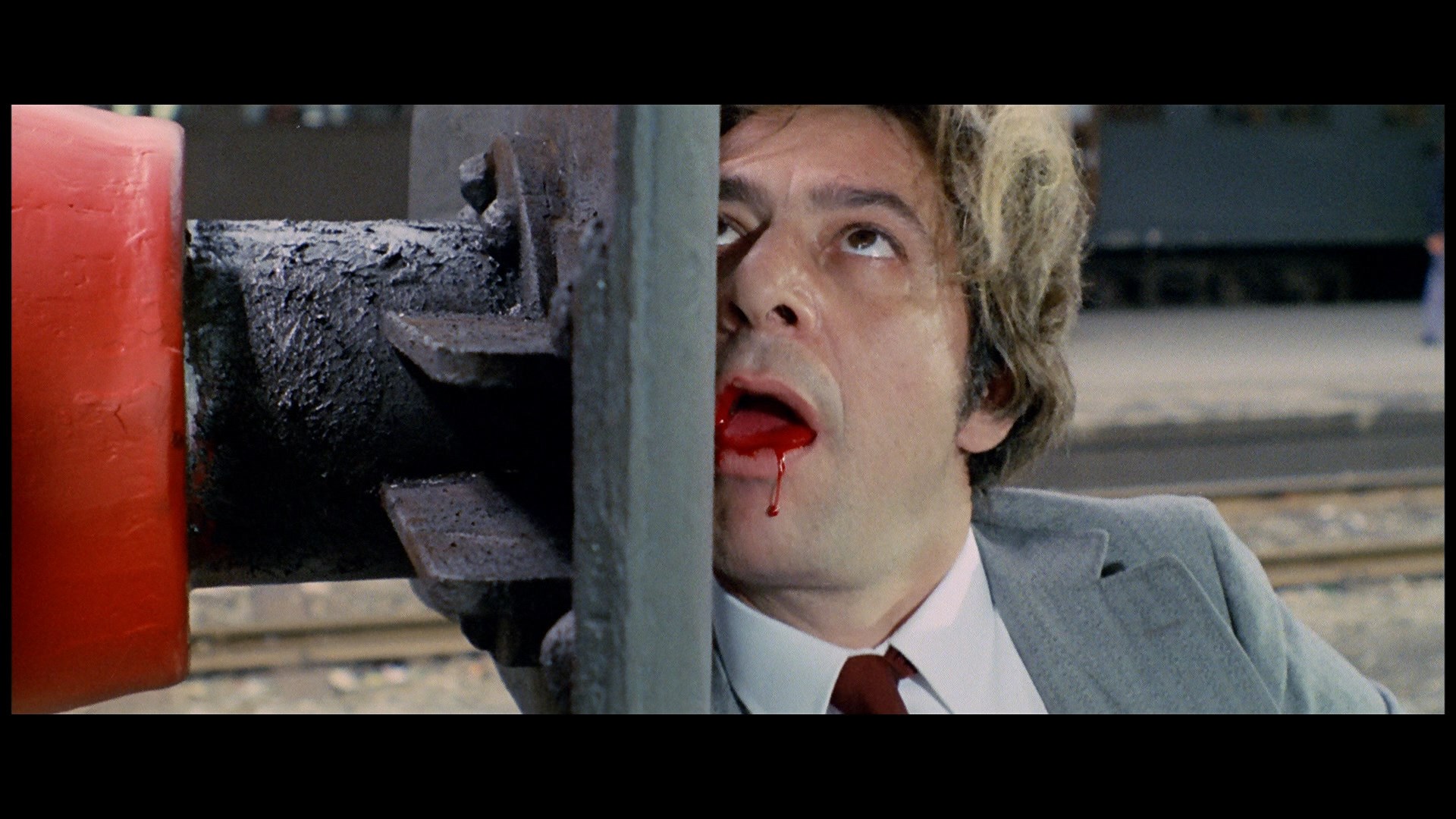
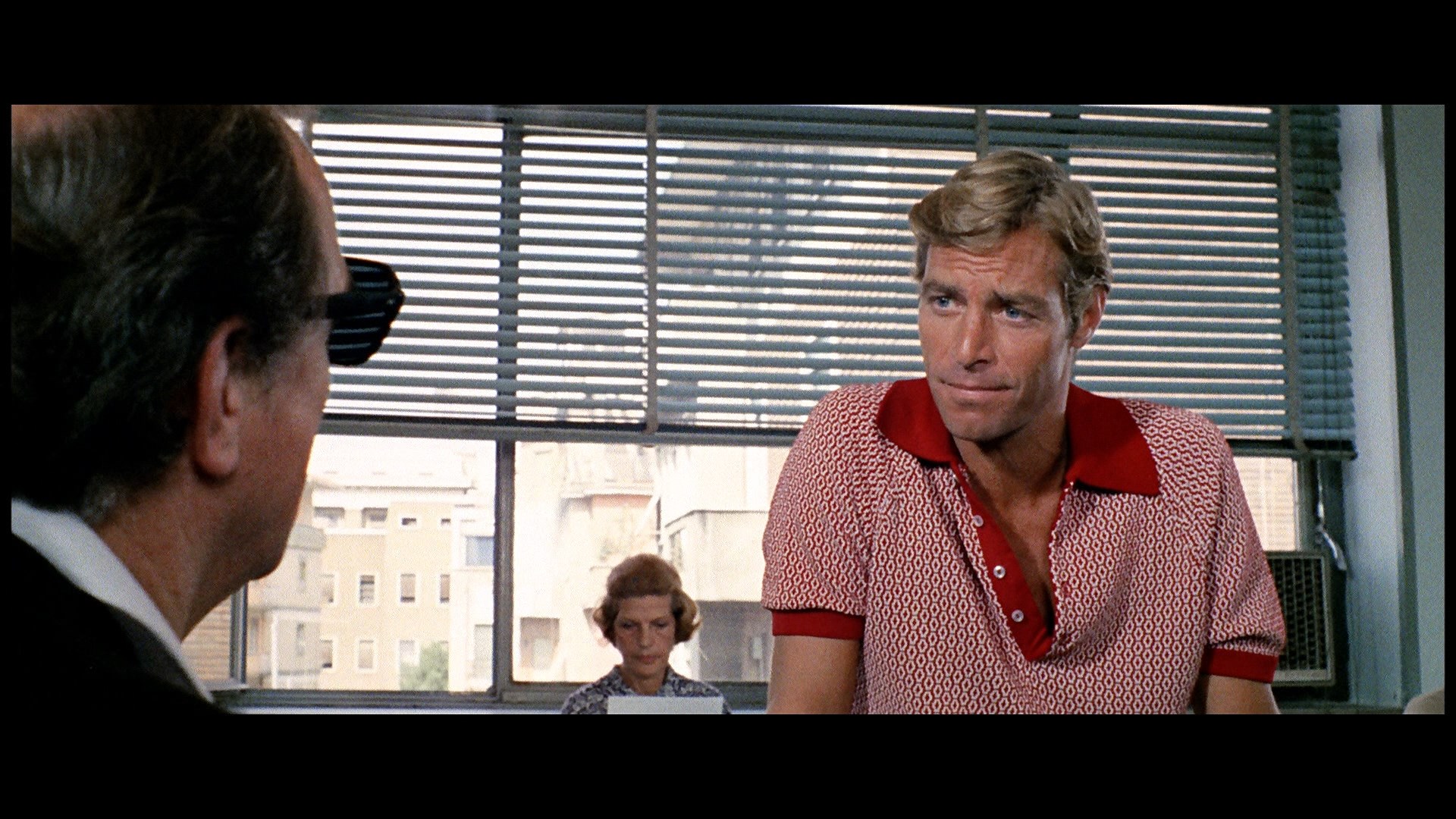
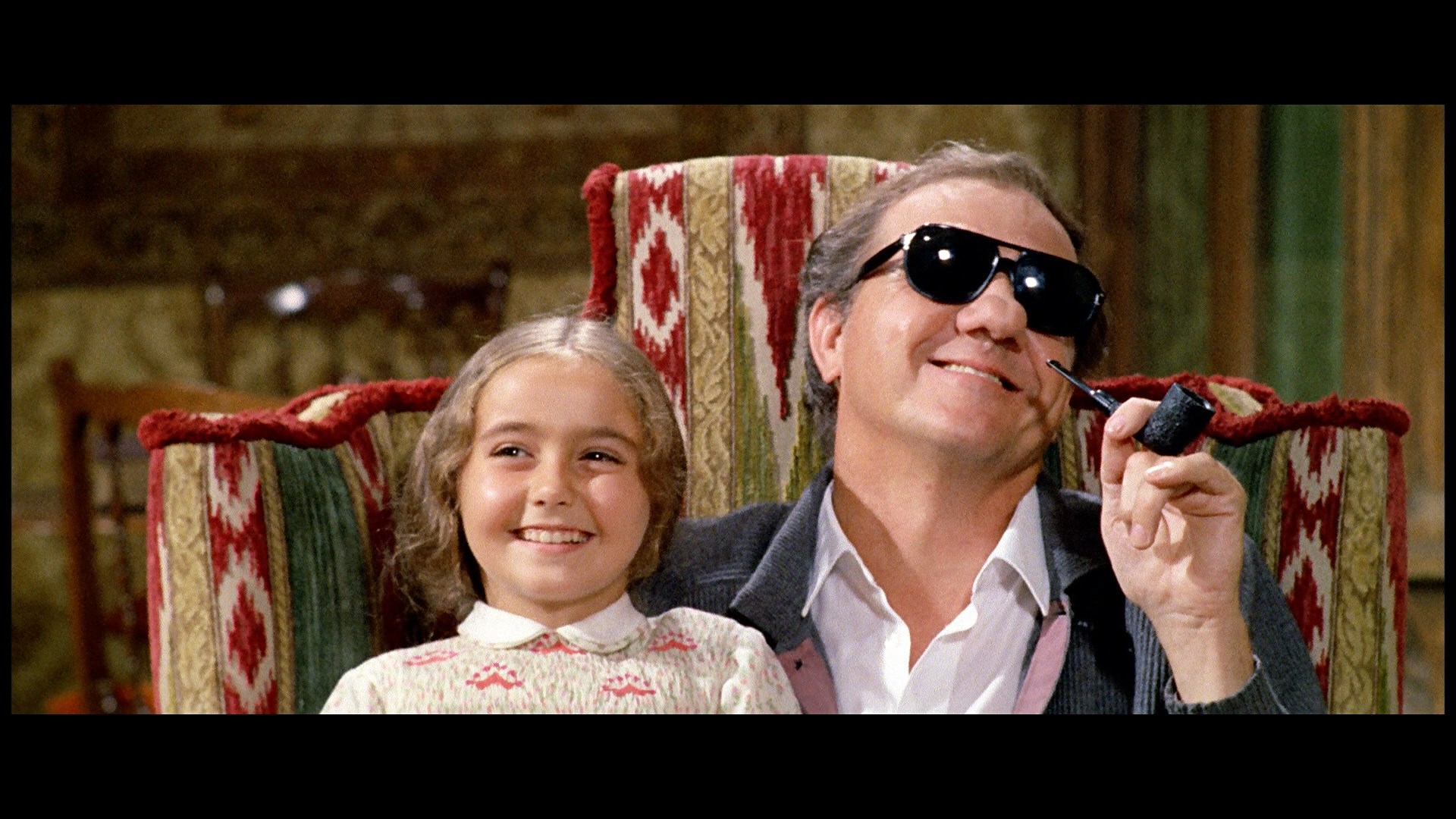
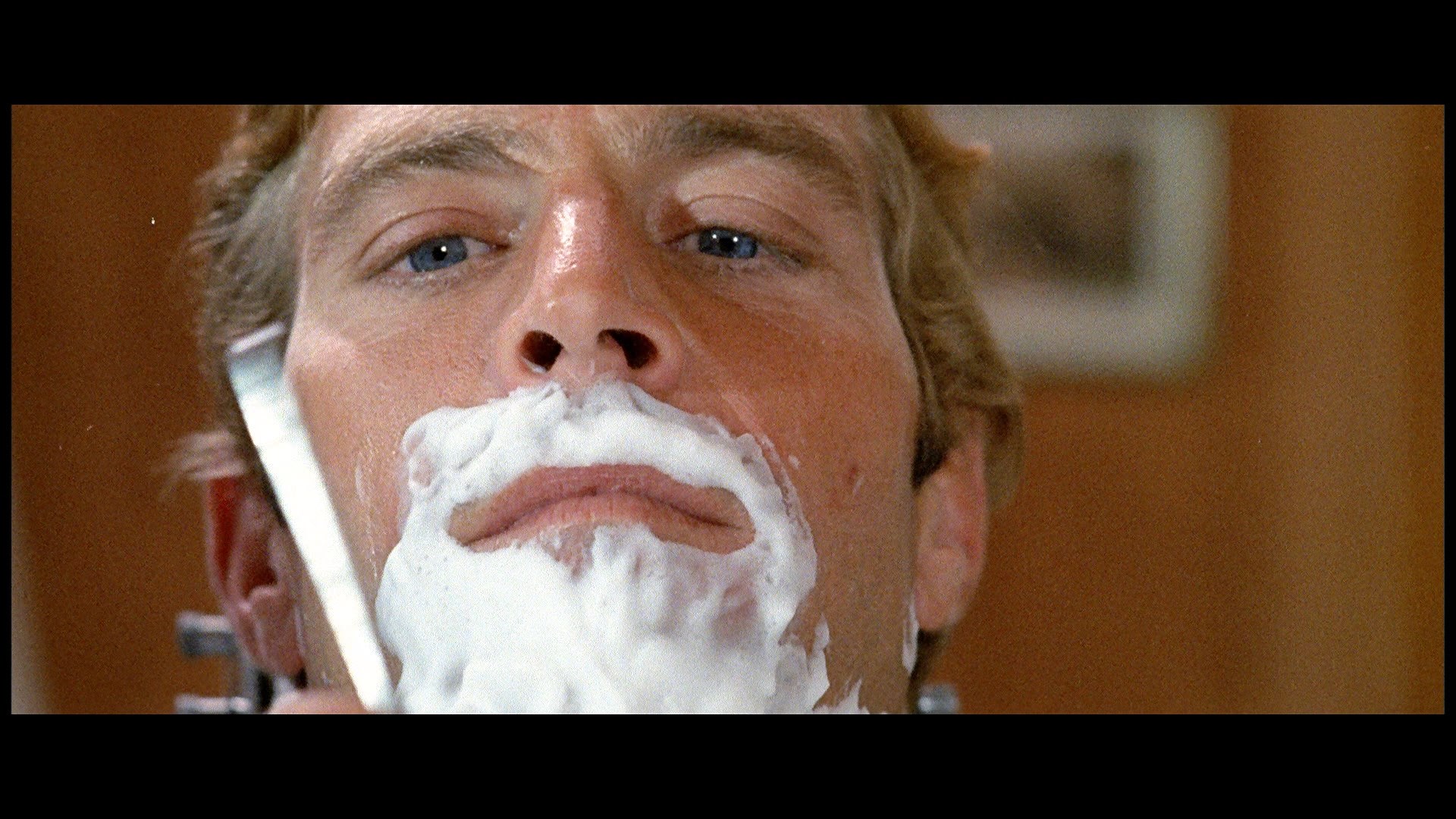
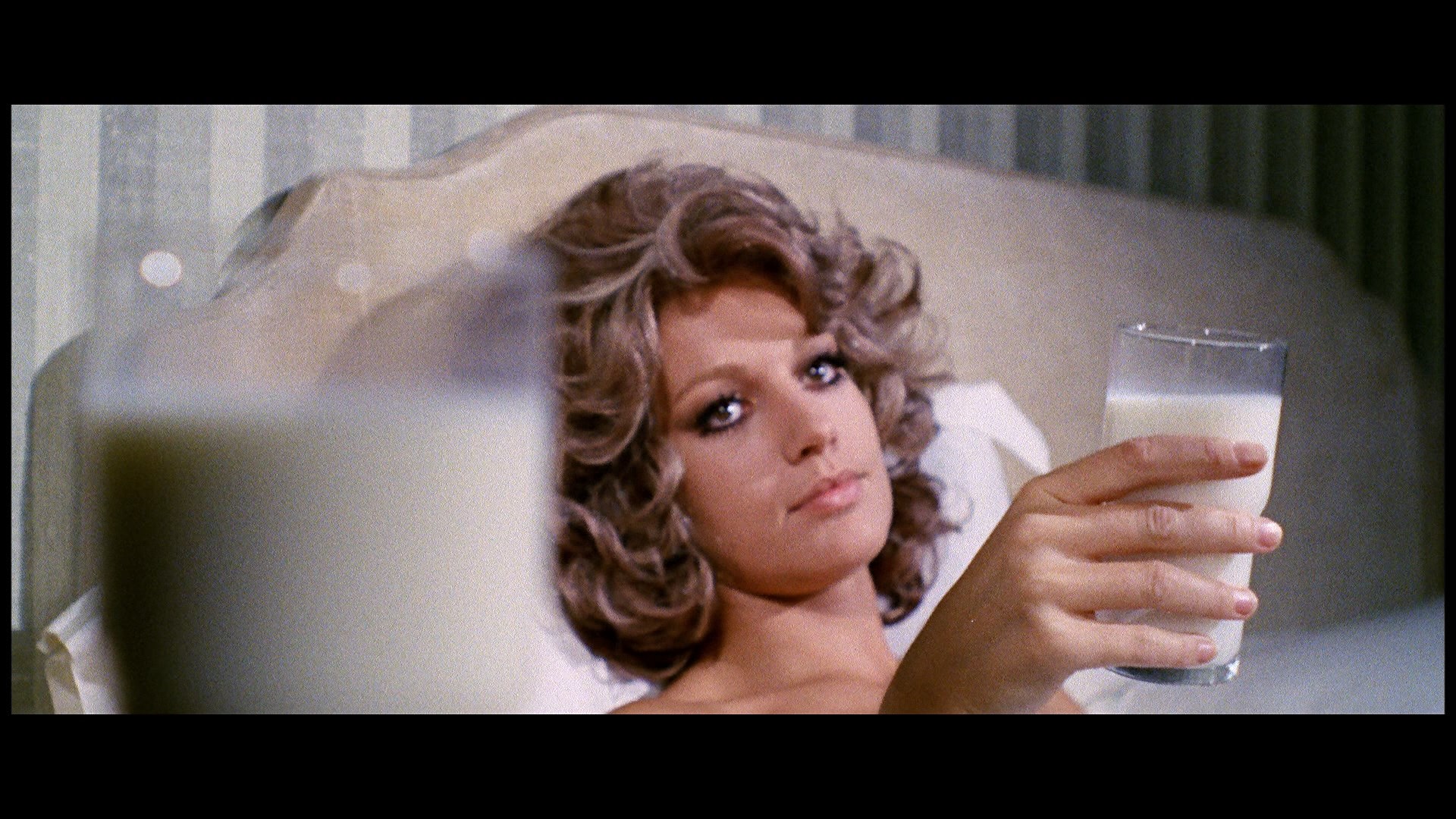
ARROW 2011 BLU-RAY
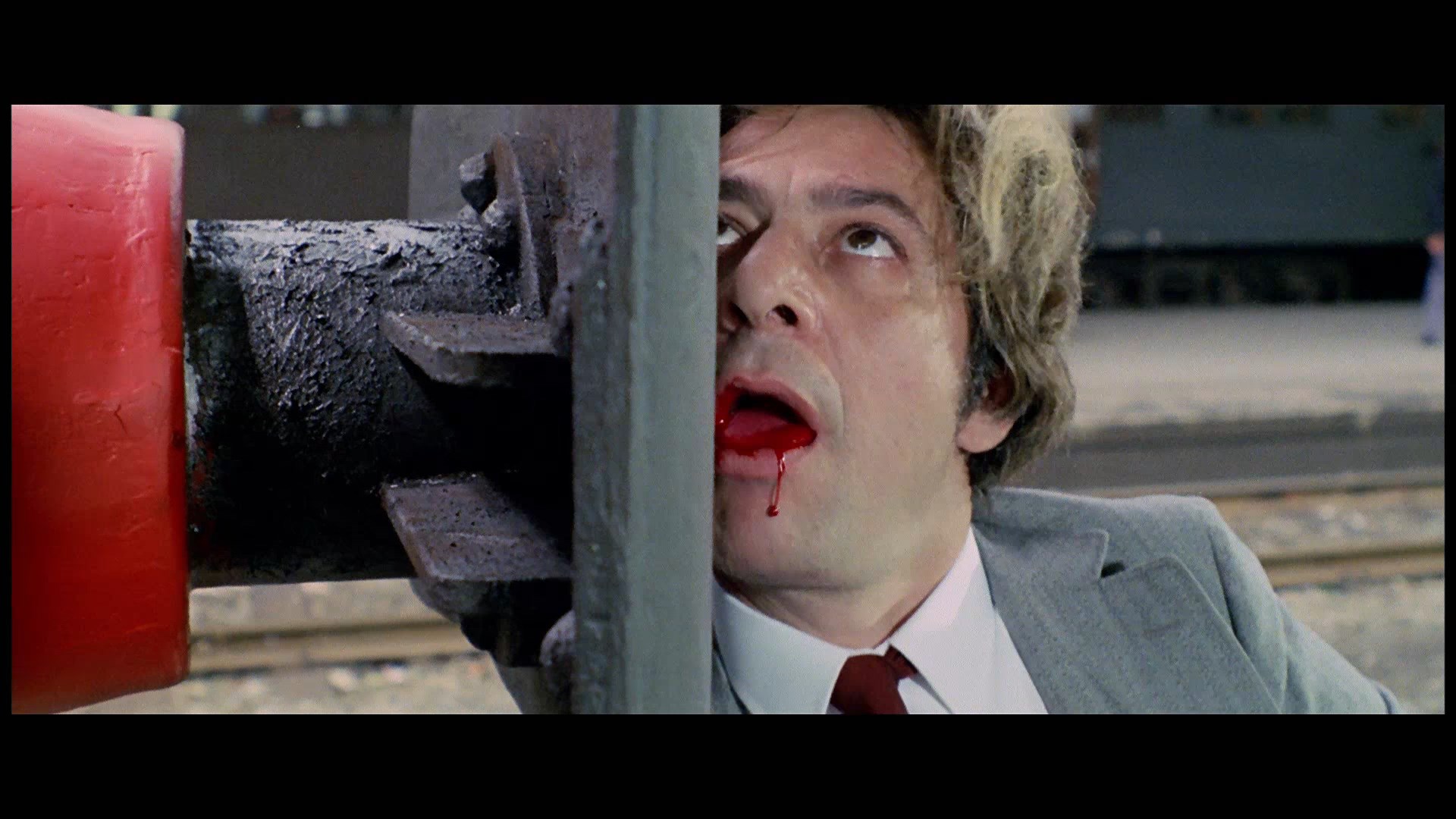

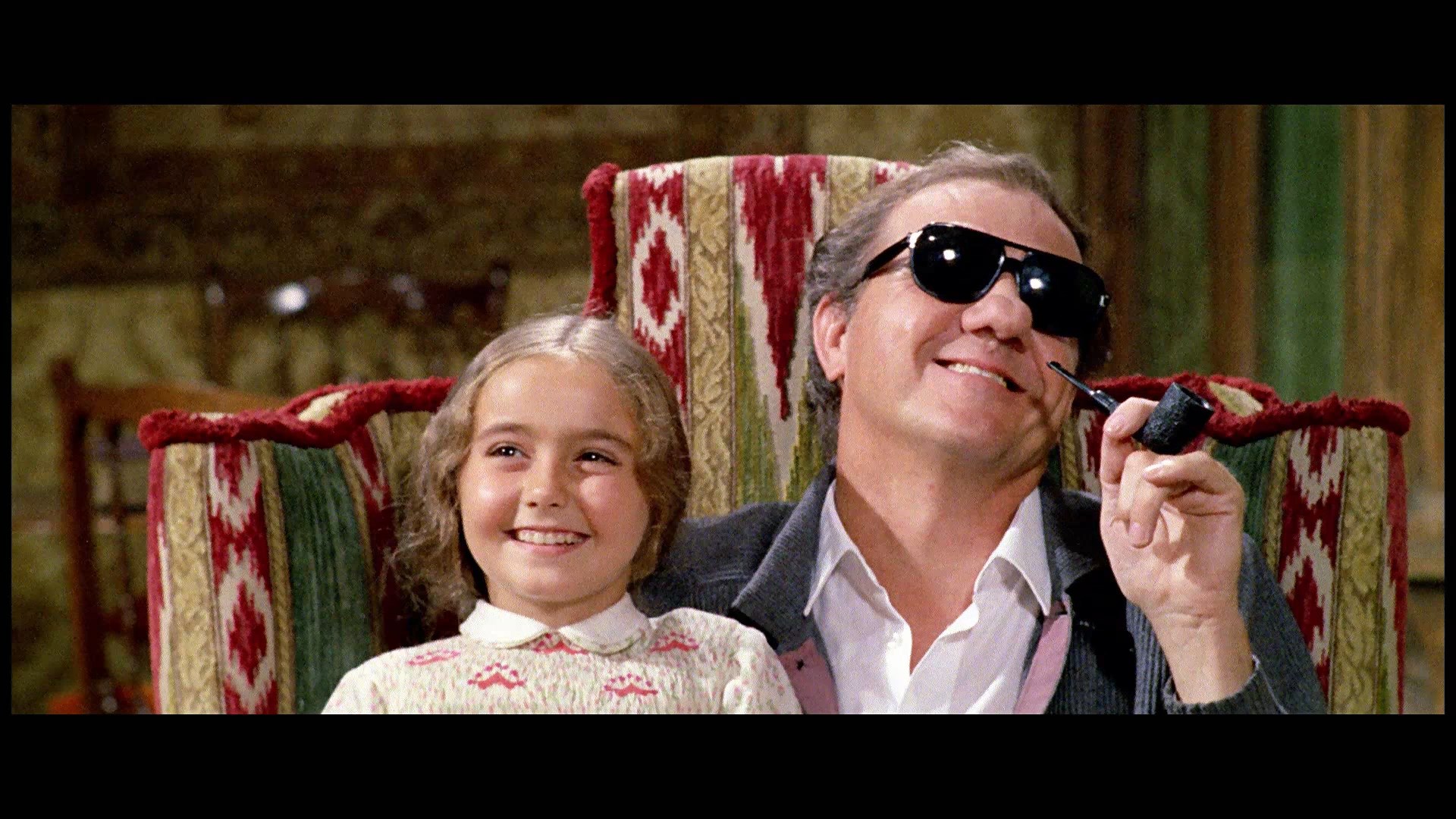


BONUS SCENES (GERMAN BLU-RAY)

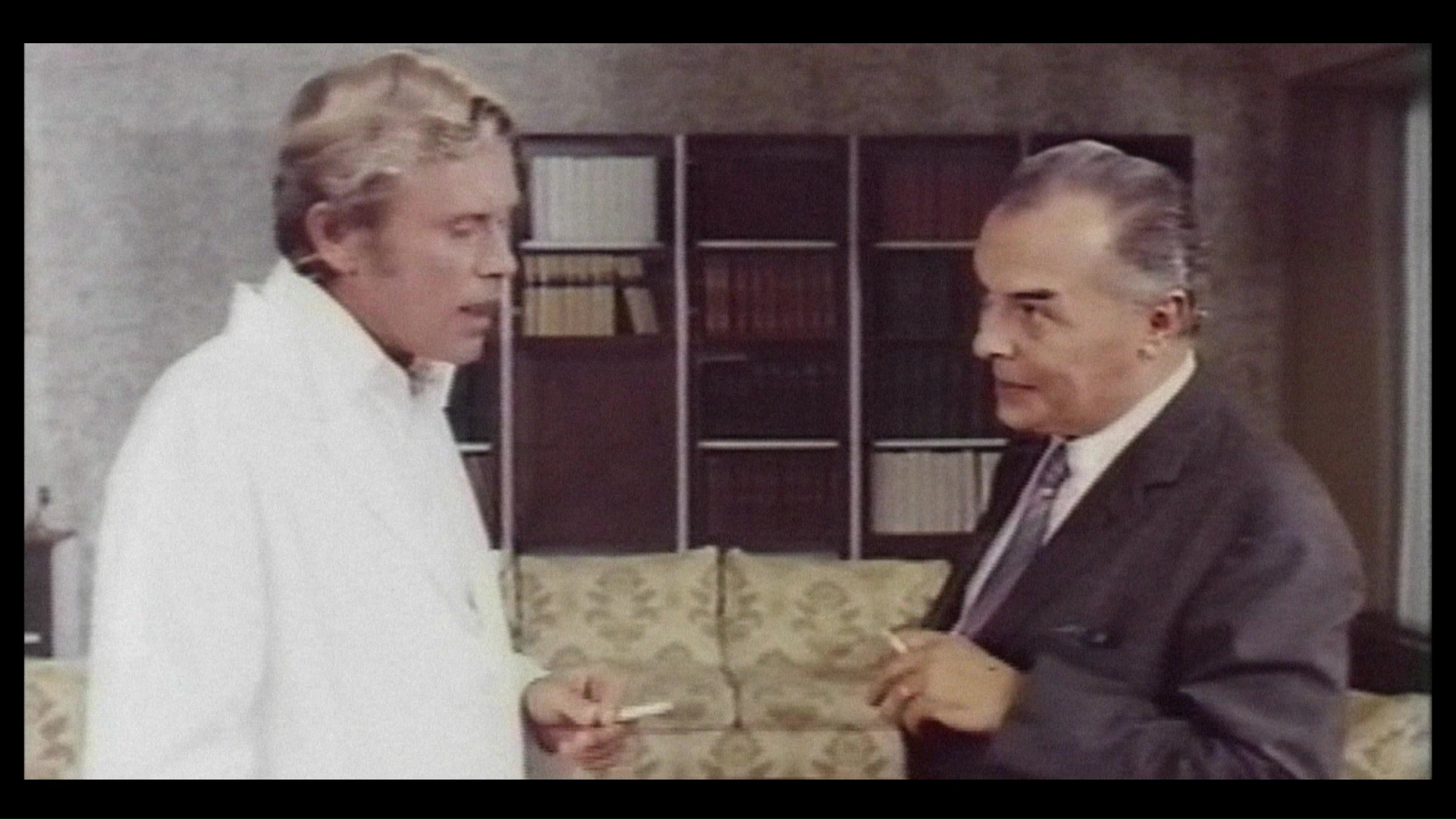
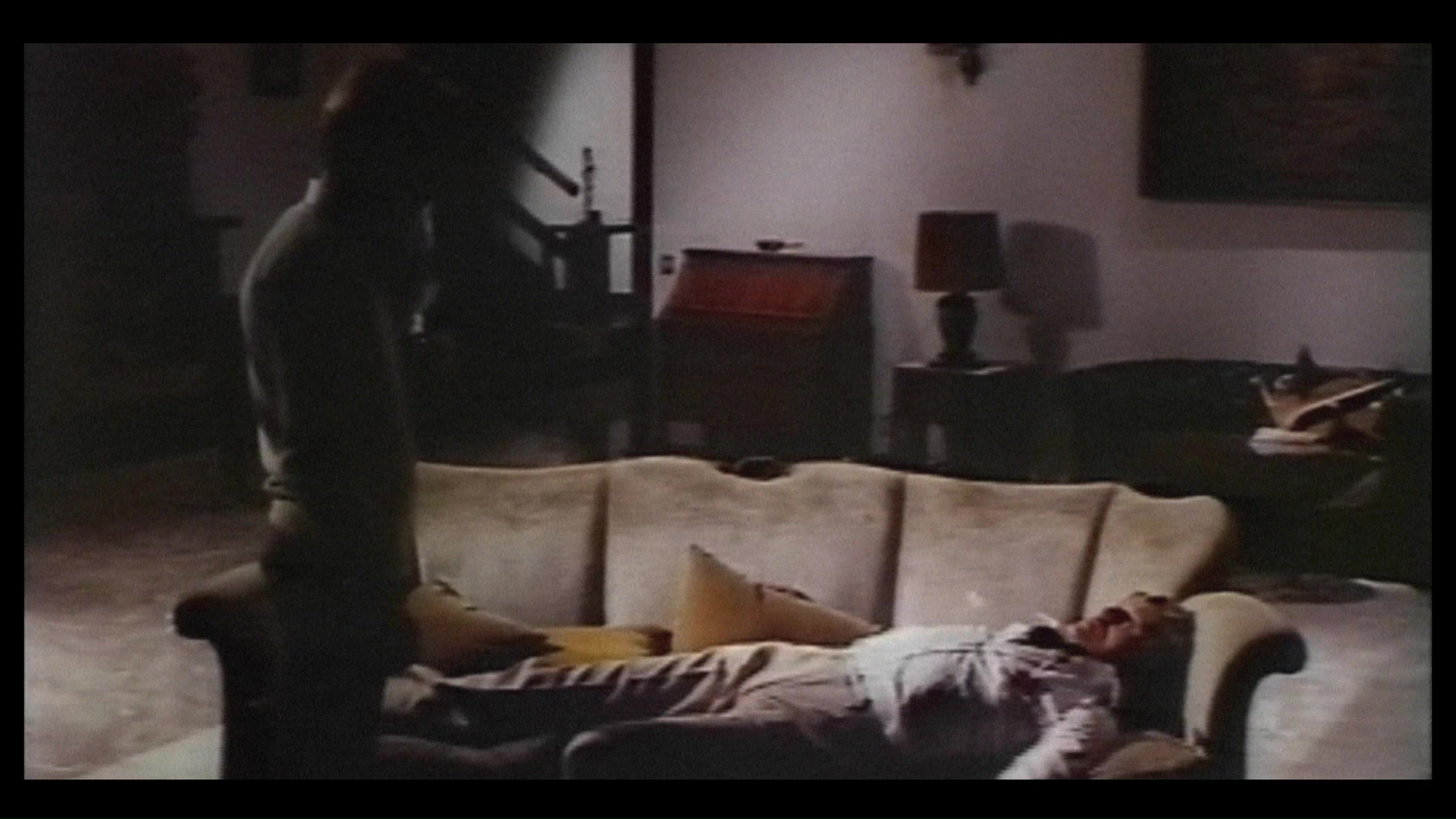
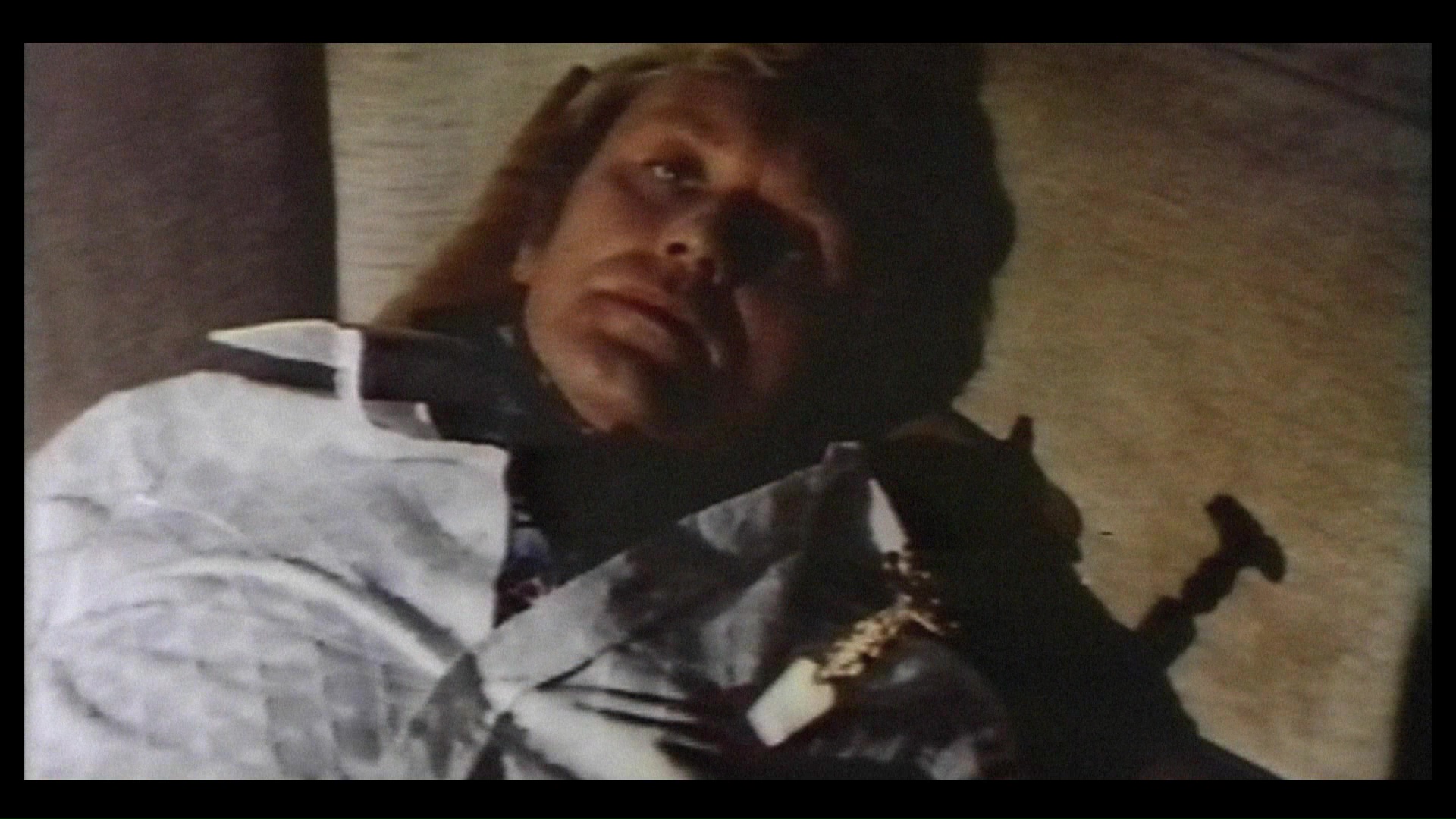
Updated review on July 8, 2021


 a major international success with his first film, The Bird with the Crystal Plumage, director Dario Argento
a major international success with his first film, The Bird with the Crystal Plumage, director Dario Argento  quickly attempted a reprise by expanding that trendsetting giallo's formula of Americans in Italy rubbing shoulders with the criminal element and a psychopathic killer. The end result, The Cat o' Nine Tails, didn't initially capture the critical and commercial appeal of that first hit thanks to its abrasive insistence on refusing to conform to expectations as romantic subplots, whodunit elements, and standard three-act plotting are all tossed out the window with a glee bordering on the sadistic, allowing Argento instead to experiment with the template of a murder mystery in which form and style coexist most uneasily. After this film Argento returned one year later with the even more radical Four Flies on Grey Velvet before launching onto a different plane entirely with two masterpieces in a row, Deep Red and Suspiria.
quickly attempted a reprise by expanding that trendsetting giallo's formula of Americans in Italy rubbing shoulders with the criminal element and a psychopathic killer. The end result, The Cat o' Nine Tails, didn't initially capture the critical and commercial appeal of that first hit thanks to its abrasive insistence on refusing to conform to expectations as romantic subplots, whodunit elements, and standard three-act plotting are all tossed out the window with a glee bordering on the sadistic, allowing Argento instead to experiment with the template of a murder mystery in which form and style coexist most uneasily. After this film Argento returned one year later with the even more radical Four Flies on Grey Velvet before launching onto a different plane entirely with two masterpieces in a row, Deep Red and Suspiria.  participant in the blackmail discussion, so Arno teams up with scrappy newsman Carlo Giordani (Franciscus), both of whom get more than they bargained for. Carlo gets close to Anna (Spaak), the mysterious daughter of the institute chairman, while Arno chases down several clues of his own. Meanwhile the garrote-wielding killer continues to strike again and again, determined to cover up a most deadly secret.
participant in the blackmail discussion, so Arno teams up with scrappy newsman Carlo Giordani (Franciscus), both of whom get more than they bargained for. Carlo gets close to Anna (Spaak), the mysterious daughter of the institute chairman, while Arno chases down several clues of his own. Meanwhile the garrote-wielding killer continues to strike again and again, determined to cover up a most deadly secret. 
 punctuated by disturbing musical clicks, yowls, and thuds. Cat also finds Argento experimenting more with the possibilities of editing to layer his narrative, such as the obvious example of subliminal flashes used to indicate an upcoming scene or recap an important piece of information. He later expanded on this technique in Four Flies (particularly the memorable finale) and, most effectively, in the celebrated visual and verbal echoing of Deep Red. The murder sequences themselves are brutal though comparatively light on blood; in fact, the rough rooftop finale is the goriest sequence in the film, sort of a savage updating of the climax from To Catch a Thief. The strangulation of Rada Rassimov is probably the most memorably brutal moment though, a protracted bit of nastiness with touches which Argento would later repeat and embellish in Deep Red as well.
punctuated by disturbing musical clicks, yowls, and thuds. Cat also finds Argento experimenting more with the possibilities of editing to layer his narrative, such as the obvious example of subliminal flashes used to indicate an upcoming scene or recap an important piece of information. He later expanded on this technique in Four Flies (particularly the memorable finale) and, most effectively, in the celebrated visual and verbal echoing of Deep Red. The murder sequences themselves are brutal though comparatively light on blood; in fact, the rough rooftop finale is the goriest sequence in the film, sort of a savage updating of the climax from To Catch a Thief. The strangulation of Rada Rassimov is probably the most memorably brutal moment though, a protracted bit of nastiness with touches which Argento would later repeat and embellish in Deep Red as well.

 chase scenes); this wretched presentation is still available on bootleg DVD from several bargain labels. (Also like Bird, Cat was rated GP for its theatrical U.S. run, which just goes to show how out of whack the MPAA has gotten in the last few decades.)
chase scenes); this wretched presentation is still available on bootleg DVD from several bargain labels. (Also like Bird, Cat was rated GP for its theatrical U.S. run, which just goes to show how out of whack the MPAA has gotten in the last few decades.)  of the circumstances which led to the film's creation, complete with views of its successes and faults, though Argento seems a bit too hard on it in retrospect. The promotional material is at least as interesting; an immaculate international trailer features a delirious mixture of footage and tinted stills to create a genuinely appealing promotional piece, including a psychedelic rock instrumental borrowed from the film May Morning. This trailer was obviously reworked to lesser effect for the U.S. trailer and TV spots (in much more battered condition), which spoil the visuals with some unconvincing verbal hype. Finally you get some appreciative liner notes by Travis Crawford, a gallery of posters and stills, and two radio promos featuring some highly unorthodox soundbites from the two stars.
The Dutch DVD features a similar English-
of the circumstances which led to the film's creation, complete with views of its successes and faults, though Argento seems a bit too hard on it in retrospect. The promotional material is at least as interesting; an immaculate international trailer features a delirious mixture of footage and tinted stills to create a genuinely appealing promotional piece, including a psychedelic rock instrumental borrowed from the film May Morning. This trailer was obviously reworked to lesser effect for the U.S. trailer and TV spots (in much more battered condition), which spoil the visuals with some unconvincing verbal hype. Finally you get some appreciative liner notes by Travis Crawford, a gallery of posters and stills, and two radio promos featuring some highly unorthodox soundbites from the two stars.
The Dutch DVD features a similar English- language transfer with Dutch subtitles, while the French disc contains Italian and French tracks with optional French subtitles. One interesting alternative is the Medusa disc from Italy which offers a few twists of its own and is worth picking up for Argento die-hards. The Italian language version is presented in Dolby Digital 5.1 or 2.0 mono with optional English subtitles; while the 5.1 track is an artificial-sounding wreck (though not as disastrous as Medusa's botched mix on Tenebrae), the 2.0 mix sounds fine and offers a somewhat different experience from the English language edition. The actors are voiced in a far more lively fashion which, surprisingly enough, gives the film a markedly energetic and engaging tone, while the murders feature far more dramatic screaming, gurgling, and other noises the voice artists conjured up probably after swilling a lot of vino. No extras to speak of.
language transfer with Dutch subtitles, while the French disc contains Italian and French tracks with optional French subtitles. One interesting alternative is the Medusa disc from Italy which offers a few twists of its own and is worth picking up for Argento die-hards. The Italian language version is presented in Dolby Digital 5.1 or 2.0 mono with optional English subtitles; while the 5.1 track is an artificial-sounding wreck (though not as disastrous as Medusa's botched mix on Tenebrae), the 2.0 mix sounds fine and offers a somewhat different experience from the English language edition. The actors are voiced in a far more lively fashion which, surprisingly enough, gives the film a markedly energetic and engaging tone, while the murders feature far more dramatic screaming, gurgling, and other noises the voice artists conjured up probably after swilling a lot of vino. No extras to speak of. 
 The House by the Cemetery, or much of the Raro catalog. Since its release this was often been cited as the most visually drab of Argento's classic films, but that view was finally put firmly to rest as it's now obvious that it was originally shot in rich, Technicolor hues that rival the most striking images in his other two "Animal Trilogy" thrillers. From Malden's book-lined apartment to the sleek, Tenebrae-style modernistic interiors of the Terzi Instititue, the film takes a significant step forward in aesthetic rewards here with better color and detail than earlier transfers, though it would be outdone as you'll see below. The image clarity is so fine you can also clearly see how they pulled off the fleeting but very nasty cheek-slashing effect with a scalpel, too. The English opening and closing titles are now in mint condition as well. The English, Italian, and French tracks are all present here along with the of subtitles in English, French, and Spanish; the one caveat is that the English subs are SDH, which means that sound effects and voice directions are included as well which might make it a bit awkward for anyone watching it in Italian. The featurette, trailers, TV and radio spots are all included; the only missing extra is the stills gallery, which is a shame as it included a glimpse of the film's deleted epilogue which concluded in a more traditional and romantic fashion. Incidentally, fans may also want to seek out the 1971 movie tie-in paperback, which features yet another resolution as well as numerous bits of additional character and plot information. A subsequent UK Blu-ray from Arrow the same year was taken from the same transfer but featured a vastly inferior presentation
The House by the Cemetery, or much of the Raro catalog. Since its release this was often been cited as the most visually drab of Argento's classic films, but that view was finally put firmly to rest as it's now obvious that it was originally shot in rich, Technicolor hues that rival the most striking images in his other two "Animal Trilogy" thrillers. From Malden's book-lined apartment to the sleek, Tenebrae-style modernistic interiors of the Terzi Instititue, the film takes a significant step forward in aesthetic rewards here with better color and detail than earlier transfers, though it would be outdone as you'll see below. The image clarity is so fine you can also clearly see how they pulled off the fleeting but very nasty cheek-slashing effect with a scalpel, too. The English opening and closing titles are now in mint condition as well. The English, Italian, and French tracks are all present here along with the of subtitles in English, French, and Spanish; the one caveat is that the English subs are SDH, which means that sound effects and voice directions are included as well which might make it a bit awkward for anyone watching it in Italian. The featurette, trailers, TV and radio spots are all included; the only missing extra is the stills gallery, which is a shame as it included a glimpse of the film's deleted epilogue which concluded in a more traditional and romantic fashion. Incidentally, fans may also want to seek out the 1971 movie tie-in paperback, which features yet another resolution as well as numerous bits of additional character and plot information. A subsequent UK Blu-ray from Arrow the same year was taken from the same transfer but featured a vastly inferior presentation  with some major sync issues throughout the English soundtrack. That said, the release may be of some interest to Argentophiles for its exclusive video interviews with Argento (10m31s), Luigi
with some major sync issues throughout the English soundtrack. That said, the release may be of some interest to Argentophiles for its exclusive video interviews with Argento (10m31s), Luigi  Cozzi (16m24s), and for some reason Sergio Martino (24m5s), plus liner notes by Alan Jones.
Cozzi (16m24s), and for some reason Sergio Martino (24m5s), plus liner notes by Alan Jones.  ephemera.
ephemera.  transfer from the original negative that results in a presentation similar to its 2017 work on Crystal Plumage; in other words it's definitely going to provoke strong reactions as it looks darker, richer, subtly graded, and with much more fine film grain versus the more digitized look of the older transfer. The compression is extremely attentive as well and doesn't result in any visible issues. Both the English and Italian tracks are included back in their original mono (DTS-HD MA), sounding excellent, with optional English or English SDH subtitles for whichever you choose (and title sequences and text inserts in English or Italian as well). An audio commentary with the reliable team of Alan Jones and Kim Newman is a major plus as well, covering Argento's newcomer status at the time as a director (and his stated disdain for this film years later), the prevalence of blindness-themed thrillers before and around this time, the state of the Italian film industry at the time, and plenty more. A new Argento interview, "Nine Lives" (15m57s), reiterates the "stereotypical American elements" that dissatisfied him (in contrast to the positive audience response), the Turin location scouting, an allusion to "terrible pranks" pulled by the crew in the cemetery scene, his fondness for Malden, and his own newspaper background. In "The Writer o' Many Tales" (34m46s), wildly productive and influential screenwriter Dardano Sacchetti covers his own passion for cinema that got him into the business, his first meeting with Argento, and the real-life inspiration for the aberrant chromosome plot device that plays a pivotal role in the story. A new interview with De Carolis, "Child Star" (11m2s), is worth checking out as the former child star talks about working with Malden (whose fame was unknown to her at the time), her mother's constant presence on
transfer from the original negative that results in a presentation similar to its 2017 work on Crystal Plumage; in other words it's definitely going to provoke strong reactions as it looks darker, richer, subtly graded, and with much more fine film grain versus the more digitized look of the older transfer. The compression is extremely attentive as well and doesn't result in any visible issues. Both the English and Italian tracks are included back in their original mono (DTS-HD MA), sounding excellent, with optional English or English SDH subtitles for whichever you choose (and title sequences and text inserts in English or Italian as well). An audio commentary with the reliable team of Alan Jones and Kim Newman is a major plus as well, covering Argento's newcomer status at the time as a director (and his stated disdain for this film years later), the prevalence of blindness-themed thrillers before and around this time, the state of the Italian film industry at the time, and plenty more. A new Argento interview, "Nine Lives" (15m57s), reiterates the "stereotypical American elements" that dissatisfied him (in contrast to the positive audience response), the Turin location scouting, an allusion to "terrible pranks" pulled by the crew in the cemetery scene, his fondness for Malden, and his own newspaper background. In "The Writer o' Many Tales" (34m46s), wildly productive and influential screenwriter Dardano Sacchetti covers his own passion for cinema that got him into the business, his first meeting with Argento, and the real-life inspiration for the aberrant chromosome plot device that plays a pivotal role in the story. A new interview with De Carolis, "Child Star" (11m2s), is worth checking out as the former child star talks about working with Malden (whose fame was unknown to her at the time), her mother's constant presence on  location, and her more vague memories of the later Cannibal Apocalypse opposite John Saxon. In "Giallo in Turin" (15m11s), production manager Angelo Iacono goes into more detail about the city choice for the shoot and explains how the high-speed chase
location, and her more vague memories of the later Cannibal Apocalypse opposite John Saxon. In "Giallo in Turin" (15m11s), production manager Angelo Iacono goes into more detail about the city choice for the shoot and explains how the high-speed chase  scene was achieved, plus his other work on the set including serving as the deputy for Argento's father/producer. The most in-depth look at the film's discarded original, greatly expanded ending is included here with an English translation of the original script along with copious illustrations showing how the story originally wrapped up all of the pivotal characters. The international, Italian, and American trailers are included, while the limited edition Blu-ray and DVD set also includes reversible sleeve options (original poster art or a striking new red-themed design by Candice Tripp), a double-sided fold-out poster, four reproduction lobby cards, and an illustrated booklet featuring an essay by Argento and new liner notes by Barry Forshaw, Troy Howarth and Howard Hughes.
scene was achieved, plus his other work on the set including serving as the deputy for Argento's father/producer. The most in-depth look at the film's discarded original, greatly expanded ending is included here with an English translation of the original script along with copious illustrations showing how the story originally wrapped up all of the pivotal characters. The international, Italian, and American trailers are included, while the limited edition Blu-ray and DVD set also includes reversible sleeve options (original poster art or a striking new red-themed design by Candice Tripp), a double-sided fold-out poster, four reproduction lobby cards, and an illustrated booklet featuring an essay by Argento and new liner notes by Barry Forshaw, Troy Howarth and Howard Hughes.

















